#9 January 1455
Text









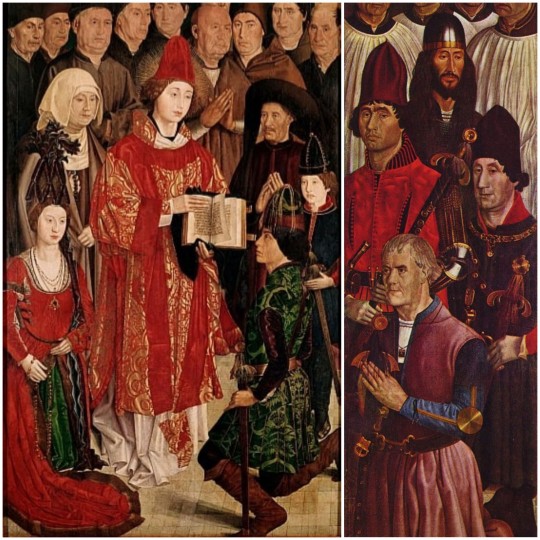
The Bastard Kings and their families
This is series of posts are complementary to this historical parallels post from the JON SNOW FORTNIGHT EVENT, and it's purpouse to discover the lives of medieval bastard kings, and the following posts are meant to collect portraits of those kings and their close relatives.
In many cases it's difficult to find contemporary art of their period, so some of the portrayals are subsequent.
1) John I of Portugal (1357 – 1433), son of Peter I of Portugal and Teresa Lourenço; with his wife, Philippa of Lancaster (1360 – 1415), daughter of John of Gaunt and his wife Blanche of Lancaster
2) His father, Peter I of Portugal (1320 – 1367), son of Afonso IV of Portugal and his wife Beatrice of Castile
3) His sister, Beatrice of Portugal (c. 1354–1381), daugther of Peter I of Portugal and his wife Inês de Castro
4) His brother, John of Portugal (1352 – c. 1396), son of Peter I of Portugal and his wife Inês de Castro
5) His brother, Ferdinand I of Portugal (1345 – 1383), son of Peter I of Portugal and his wife Constanza Manuel de Villena
6) His sister in law, Leonor Teles de Meneses (c. 1350 – c. 1405), daughter of Martim Afonso Telo de Meneses and his wife Aldonça Eanes de Vasconcelos
7) His niece, Beatrice of Portugal (1373 –c. 1420), daughter of Ferdinand I of Portugal and his wife Leonor Teles de Meneses
8) His niece, Isabella of Portugal (1364–1395), daughter of Ferdinand I of Portugal and an unknown woman
9) His daughter with Philippa of Lancaster, Isabella of Portugal (1397 – 1471)
10) Left:
I. Eleanor of Aragon (1402 – 1445), daughter of Ferdinand I of Aragon and his wife Leonor de Albuquerque; and wife of Edward I of Portugal
II. Isabella of Coimbra (1432 – 1455), daughter of Peter of Portugal and Isabella of Urgell; wife of Afonso V of Portugal
III. Edward I of Portugal (1391 – 1438), son of John I of Portugal and his wife Philippa of Lancaster
IV. John II of Portugal (1455 – 1495), son of Afonso V of Portugal and his wife Isabella of Coimbra
V. Afonso V of Portugal 15 (1432 – 1481), son of Edward I of Portugal and his wife Eleanor of Aragon
Right:
I. Ferdinand of Portugal (1402 – 1443), son of John I of Portugal and his wife Philippa of Lancaster
II. John of Portugal (January 1400 – 1442) son of John I of Portugal and his wife Philippa of Lancaster
III. Peter of Portugal (1392 – 1449), son of John I of Portugal and his wife Philippa of Lancaster
IV. Henry of Portugal (1394 – 1460), son of John I of Portugal and his wife Philippa of Lancaster
Note: In the last picture, the Panel of the Prince or the Infante and the Panel of the Knights from Nuno Gonçalves' St. Vincent Panels, the identity of some of the members of the Royal family it's still discussed, like the man identified as Edward I in the Panel of the Prince is his brother Henry, but we're considering the interpretation of the people of the panel being Afonso V with his parents, wife and heir, and the ones of the Panel of the Knights are Edward I's brothers, although by the time the panels were painted most of them have already died.
#jonsnowfortnightevent2023#asoiaf#a song of ice and fire#day 10#echoes of the past#historical parallels#medieval bastard kings#bastard kings and their families#john i of portugal#philippa of lancaster#peter i of portugal#ferdinand i of portugal#beatrice of portugal#john of portugal#isabella of portugal#eleanor of aragon#edward i of portugal#john ii of portugal#afonso v of portugal#leonor teles de meneses#isabella of coimbra#peter of coimbra#canonjonsnow
11 notes
·
View notes
Text
Blood, sweat, and tears of the Irish: The story of Mary, Ellen, and Bridget [Part 2]
Notes
[1] "United States Census, 1860", database with images, FamilySearch, 11 November 2020, John H Packard, 1860; page 6, household ID 27, NARA M653, affiliate film number 1158, GS film number 805158, digital folder number 005171158, image number 10, indexing project batch number N01813-6, record number 218.
[2] Andrew Urban (August 2009), "Irish Domestic Servants, ‘Biddy’ and Rebellion in the American Home, 1850–1900," Gender & History, 21(2): 264; accessed January 3, 2021.
[3] Thomas Low Nichols. Forty Years of American Life (London,1864), 71; quoted on "The Irish Girl and the American Letter: Irish immigrants in 19th Century America" page.
[4] Reuters Staff, "Fact check: First slaves in North American colonies were not “100 white children from Ireland”," Reuters, June 17, 2020, accessed January 3, 2021; Michael Guasco, "Indentured Servitude," Oxford Bibliographies, December 11, 2015, accessed January 3, 2021.
[5] Edward Young, "Special report on immigration...in the year 1869-'70 /," Government Publication Office, 1871, p. 216.
[6] "1924-26 Spruce Philadelphia, PA 19103," Long & Foster Real Estate, Inc., Accessed January 3, 2021. This is also asserted on Redfin. The listing describes the house as "a remarkable and rare Italian Renaissance Mansion housing 12 residential apartments in the heart of the Rittenhouse neighborhood," saying it was "built in the late 1800's at a time when fashionable architects were employed by prominent residents making their mark on the city of Philadelphia. An early elevator residence, this magnificent building has been home to prominent Philadelphia families such as Dr. John Hooker Packard, one of the most prominent American surgeons of the late 19th century." His residence there is asserted by the Journal of Sociologic Medicine, Vol. 2, p. 419 for 1889, page 1455 Boyd's Philadelphia Combined City and Business Directory in 1895, Page 183 of the Philadelphia Historical Commission's report on historic places in Philly calls it the "Earl. P. Putnam House." His obituary transcribed on Find A Grave says he died at 1926 Spruce Street.
[7] "Have You Protected Your Family For Life?," Daily Evening Bulletin, April 6, 1864, Philadelphia, Page 4, Pennsylvania Newspaper Archive, accessed January 3, 2021. Also see notices in the April 9, 1864 paper, April 14, 1864 paper, April 12, 1864 paper, April 16, 1864 paper, April 19, 1864 paper, April 26, 1864 paper, and April 28, 1864 paper.
[8] For instance, there is a "Mary Hassin" in Northern Liberties, Philadelphia, Pennsylvania in Northern Liberties Ward 2, and another "Mary Hassen" in Moyamensing Township, Philadelphia, Pennsylvania, United States.
[9] Specifically, a 50-year-old Mary Hassan and a 55-year-old Mary Hassan.
[10] "United States Census, 1870", database with images, FamilySearch, 4 January 2021, Mary Hassen, 1870; line 12, NARA M593, GS Film Number 000552919, Digital Folder Number 004278862, image 514, indexing project (batch) number N01638-5, record number 20160.
[11] "United States Census, 1870", database with images, FamilySearch, 4 January 2021), Mary Hassen, 1870; line 32, NARA M593, GS Film Number 000552919, Digital Folder Number 004278862, image 494, indexing project (batch) number N01638-5, record number 19380.
[12] "United States Census, 1880," database with images, FamilySearch,: 13 November 2020), Mary Hassen, Philadelphia, Philadelphia, Pennsylvania; citing enumeration district ED 121, sheet 94B, NARA microfilm publication T9 (Washington, D.C.: National Archives and Records Administration, n.d.), FHL microfilm 1,255,170. Ellen Hasset and her family is mentioned on the previous page.
[14] "United States Census, 1870", database with images, FamilySearch, Ellen McBride in entry for Alfred Stille, 1870; line 16, household 964, NARA M593, GS Film Number 000552892, Digital Folder Number 004278816, image 366, indexing project (batch) number N01635-8, record number 14485.
[14] There are other measurements, but I believe this one is the most accurate to use here in this article.
[15] "The Army Medical Department Bill," The Press, Philadelphia, January 20, 1862, Page 2, accessed January 4, 2021; "New Law Books," The Press, Philadelphia, October 13, 1860, Page 3, accessed January 4, 2021; "Our Medical Schools," Daily Evening Bulletin, Philadelphia, February 6, 1866, Page 1, accessed January 4, 2021.
[16] "United States Census, 1880," database with images, FamilySearch, 13 November 2020, Rose Mc Bride in household of Richard Zeckwer, Philadelphia, Philadelphia, Pennsylvania, British Colonial America; citing enumeration district ED 133, sheet 264C, NARA microfilm publication T9 (Washington, D.C.: National Archives and Records Administration, n.d.), FHL microfilm 1,255,170.
[17] "Pennsylvania, Philadelphia Passenger Lists Index, 1800-1906," database with images, FamilySearch, Bridget Welsh, 1857; citing ship Saranak, NARA microfilm publication M360 (Washington, D.C.: National Archives and Records Administration, n.d.); FHL microfilm 419,569. There's also a person of that name which came to New York City in 1856, but I threw that one out of contention with the assumption that she stayed in Philly.
[18] "United States Census, 1880," database with images, FamilySearch, 13 November 2020), Bridget Welsh in household of Annie E. Massey, Philadelphia, Philadelphia, Pennsylvania, British Colonial America; citing enumeration district ED 162, sheet 94B, NARA microfilm publication T9 (Washington, D.C.: National Archives and Records Administration, n.d.), FHL microfilm 1,255,171.
[19] "United States Census, 1900," database with images, FamilySearch, 4 January 2021), Bridget Walsh in household of Emile Geyelin, Philadelphia city Ward 27, Philadelphia, Pennsylvania, United States; citing enumeration district (ED) 669, sheet 3B, family 75, NARA microfilm publication T623 (Washington, D.C.: National Archives and Records Administration, 1972.); FHL microfilm 1,241,469.
Note: This was originally posted on Jan. 14, 2021 on the main Packed with Packards WordPress blog (it can also be found on the Wayback Machine here). My research is still ongoing, so some conclusions in this piece may change in the future.
© 2021-2022 Burkely Hermann. All rights reserved.
#packards#census#genealogy#genealogy research#family history#servants#irish#ireland#philly#philadelphia
0 notes
Quote
And on the Monday after noon the Queen came to him, and brought my Lord Prince with her. And then he asked what the Prince's name was, and the Queen told him Edward; and then he held up his hands and thanked God thereof. And he said he never knew him till that time, nor wist not what was said to him, nor wist not where he had be whiles he hath be sick till now. And he asked who was godfathers, and the Queen told him, and he was well apaid.
Edmund Clere to John Paston I, 9 January 1455 (Firsthand description of Henry VI's meeting his infant son for the first time after coming out of his "catatonic state" [unknown illness which remains a mystery])
#The Paston Letters#I love reading other people's mail#Especially when it gives me adorable tidbits about Henry VI meeting his baby son#Henry VI#Queen Margaret#Margaret of Anjou#Marguerite d'Anjou#Edward of Westminster#Edward of Lancaster#Edward Prince of Wales#Edmund Clere#John Paston I#9 January 1455
8 notes
·
View notes
Text


Dracula and the Boyar Mane Udrische
Original in Russian: http://samlib.ru/.../dracula_ziznvzrosl_1448_1456_boyarin...
Annotation:
Of all of Dracula's associates, it is Mane Udrische who is the most interesting figure. The fate of this boyar deserves to be told separately, and the reason is not only that it was Mane who helped Dracula to become prince for the second time. Before us is a very unusual person - the traitor, who suddenly came to his senses and corrected the consequences of his betrayal. It's not every day, you have to admit...
To begin with, it is necessary to clarify how to call this boyar correctly, because in some books, they try to hide the unsoundness of his nickname and write "Udrische". All this is ridiculous because in the original Romanian letters of the 15th century, drawn in the Slavonic language, this boyar is listed as Udrische - without any "t" - so most likely, the nickname is based on the ancient Slavic verb "drill". (note: this google translated, so don't worry about his name, it will keep changing)
There is no need to be surprised, because in the Middle Ages unsound names were quite common. Suffice it to recall one of the close associates of Ivan the Terrible, a high-ranking oprichnik, called Vasily Dirty.
In the Service of Father Dracula
The first information about the boyar with the nickname Udrishche is found in the charter, issued no later than 1445, so we can say with certainty - this man made a career thanks to Dracula's father. Mane Udrische is mentioned in the charter together with his brother Stoyan (aka Stoyka). Both brothers are named as participants in the princely council.
Sometimes this charter is dated 1439-1440, which means that Mane Udrisce could have begun service not in the 1440s, but earlier - soon after Dracula's father became prince - or even earlier, that is, at a time when Dracula's father was living with his family in Sighisoara and was only a candidate for the throne.
In the Middle Ages in Romania, it was customary for any candidate for prince to gather around him a handful of trusted men from the boyar milieu to help him conduct affairs concerning politics. These people had no money or connections, but they had useful talents, such as the ability to speak well, strategic thinking, the ability to write things down on paper, etc. If the candidate became prince, all his assistants, who until then had served for free, received positions at the court, land, and other favors.
Among the confidants of Dracula's father who gathered in Sighisoara may have been Mane Udrisce, but even if he came to the service several years later, it can still be said that Dracula himself remembered "Uncle Mane" from his childhood.
There is also no doubt that in the 1440s Mane Udrisce with his younger brother Stoyan though established in the princely council, but did not play a serious role there.
The position of the two boyars can be shown by recalling the rules, according to which the medieval Romanian charters and edicts were composed. Not only that the text had to list all the boyars, who were present at the princely council on the day of the publication of the charter, but it was also required to keep the order of listing - the more noble person, the closer to the beginning of the list. That's why the fact that Mane Udrisce and his brother in the charter of Dracula's father are mentioned at the very end of the list says a lot.
Betrayal
Of course, Mane Udrische considered himself destitute, and he was not willing to accept that. He wanted to continue his career, and brother Stoyan probably held the same opinion, but both brothers understood that it was unlikely to expect new favors from Father Dracula.
Then came the memorable events of December 1446, when the Hungarian Janos Hunyadi came to Romania with an army, had Dracula's father beheaded, and installed Vladislav on the vacant throne.
Mane Udrische supported the Hungarian protégé, and did him some very valuable service, because Mane's influence in the princely council increased dramatically. In all Vladislav's letters
where Mane Udrische is mentioned, this boyar is always the first in the list of council participants. He was the last, and now he is the first! Such changes do not just happen! As for Stoyan, he became the head of the cavalry along with another boyar - Dimitar.
Awakening of Conscience
With the change of prince, Mane's career ambitions were satisfied. Manet became the most influential boyar in the council, and a higher position simply did not exist. This man's thoughts were no longer preoccupied with material concerns and, quite naturally, switched to the spiritual.
In the letter of January 2, 1450 it says that Mane Udrische gives a watermill to the monastery called Kozya. What caused such generosity is not specified, and this is quite strange, because the same letter tells in great detail the story of how the boyar Kazan and his brother Radu decided to make a gift to the monastery.
Kazan and Radu wanted abbot Joseph to include their entire family, namely their father Radul, their mother Stana, Kazan and Radu themselves, and their late brother Sahak, in the "monastery memorial". Kazan and Radu asked for "eternal remembrance" for themselves and their kin, and in return they gave a watermill and "a place under the cell" so that one of the monks could live near the mill and watch over it.
In the charter it is reported that Kazan and Radu have asked sovereign Vladislav to certify this agreement between them and the monastery, so that the next abbot will remember who should be remembered - in general, a lot of details, and in this heap somehow strange looks a single phrase that another watermill donates boyar Mane Udrische.
One gets the impression that the idea of the donation occurred to Mane suddenly when, while attending the council, he heard Kazan and Radu's request. "Well, and from me, add the mill," probably said Mane, who suddenly wanted to do a good deed, but what sins he sought to atone for with this beneficence, he did not say.
To Dracula for forgiveness
Apparently, the gift of the mill did not help much, and his conscience continued to plague Manet, so that no later than 1455 he began negotiations with Dracula.
That the initiative in these negotiations came from Manet and not from Dracula is almost certain, for we know how Dracula felt about Janos Hunyadi, the murderer of his father - a reconciliation never took place. So why would Dracula seek reconciliation with any of the traitor boyars?
Dracula had no reason to negotiate with Mane Udrische, but Mane had a reason - an unsettled conscience.
I want to remind that this boyar got into the princely council thanks to Dracula's father, and although after that Mane's career growth slowed down, it was not a sufficient reason for the careerist to condemn Dracula's father to death.
Probably in 1446 Manet Udrisce thought otherwise, but after 8 or 9 years, having received all the material benefits he wanted, he changed his mind and decided to rectify the consequences of his long-time betrayal - to return the Romanian throne to the rightful heir, i.e. Dracula.
From a purely practical point of view, it was more advantageous for Mane not to do anything, because the risk was serious:
1) Who knows how Dracula would behave at the first meeting - maybe just seeing a traitor, would cut him down and would not listen to anything;
2) Vladislav could have found out about the negotiations with Dracula, and then Mane would have been executed;
3) The coup d'état could have failed, in which case Mane would also have paid with his head.
And yet this boyar decided to act - he sought out Dracula, who was at that time in Moldavia or Transylvania, repentantly bowed his head to him and offered help.
In the service of Dracula.
The fact that negotiations really took place is not doubtful, because of all the boyars who betrayed father Dracula, Mane Udrisce and his brother Stoyan were the only ones mentioned in the letters of Dracula himself. The other traitors (12 people) are not mentioned by Dracula even once. They are not mentioned in the letters of subsequent sovereigns. These
boyars simply disappeared, and what happened to them is clear - they were put on a stake.
So why did Mane Udrishe and Stoyan escape this fate? There is only one answer - they helped Dracula to regain power and told about the details of the boyar conspiracy, which could not be found out by studying the archives.
It is also important that Mane Udrisce with his brother Stoyan repented in time, because it is obvious that in the autumn of 1456, when Dracula had already overthrown Vladislav, the remaining boyar traitors also tried to beg for forgiveness. The 12 previously unrepentant conspirators were shedding tears and saying they were sorry, but it was too late. Mane Udrische and Stoian repented beforehand - no later than 1455 - and therefore survived.
Secret agent for the recruitment of the boyars
It is not known how Mane's conversation with Dracula took place when the boyar came to the son of his former sovereign for the first time, but the outcome is known.
Dracula agreed to accept help from Mane, but set a condition: "I will no longer forgive any of my father's traitors - I forgive only you and your brother - so if you pull any of Vladislav's boyars to my side, pull only those who have recently entered his service and have not stained themselves with betrayal.
Manet returned to the Romanian court and began to conduct "subversive activities" there - he spoke with several boyars from the princely council, offering to go into the service of Dracula.
As Mane had promised his new lord, he spoke only to the new boyars, and eventually recruited several. These boyars are mentioned in Dracula's letters of commendation:
1) Kazan Sahak, the same one who in 1450 gave a watermill to the Kozia monastery, and he got his nickname from the name of his deceased brother. Some researchers write that Kazan served as head of the Chancellery of Prince Alexander Aldea in 1431-1436, as well as his father Dracula in 1445, but in the charters of those times Kazan is mentioned without a nickname, so it is likely that the head of the Chancellery was another boyar with the same name, and Kazan Sahakov to Vladislav did not serve anyone.
2) Stan Naegrev - the son of boyar Naegrev, who served as head of the cavalry of prince Dan. Stan Naegrev served no one before Vladislav.
3) Duka - he descended from a Greek family. He served no one before Vladislav.
The subversive activities of Mane continued until the spring of 1456, and then the preparation for a coup d'état began.
In a letter dated April 15, 1456, drawn up shortly before Vladislav was overthrown by Dracula, there remains evidence that Mane Udrische was not present at the council that day. Instead of Mane, his son Dragomir Udrisce sat there, and the boyar himself apparently went to Dracula in Transylvania to give an account of the work done and to discuss all the details of the impending seizure of power one last time.
Further Fate
Dracula came to power in August 1456, and the boyar Mane Udrische is mentioned for the last time in a charter dated April 16, 1457. His younger brother Stoyan is mentioned for the last time on September 20, 1459.
Researcher M.Cazacu in his book "Dracula" hints that these boyars disappeared from the charters because they were executed, but it is unlikely that Cazacu is right. One must not forget that Mane Udrische and his brother in the second half of the 1450s were already in a respectable age. Both were under 60 years old, and Dracula was a vigorous ruler, constantly going on campaigns, so it is likely that the elderly boyars simply could not cope with the pace and decided to retire.
Another argument for a peaceful departure has to do with the fate of Mane's estates. If Dracula had executed this boyar, he would have confiscated his land, but this did not happen. It is known that Mane's son Dragomir inherited the estates.
Dragomir is not mentioned in Dracula's charters, but is mentioned by Radu the Beautiful, as well as by subsequent sovereigns.
#Vlad voda#Vlad Tepes#Vlad Dracula#vlad the impaler#Ladislau Dragkwlya#history#wallachia#romania#vlad dracula tepes#article#Dracula and the Boyar Mane Udrische
39 notes
·
View notes
Text
Saints&Reading: Tue., Jan. 25, 2022
January 25_January12
THE MONK MARTINIAN OF BELOZERSK (1483)
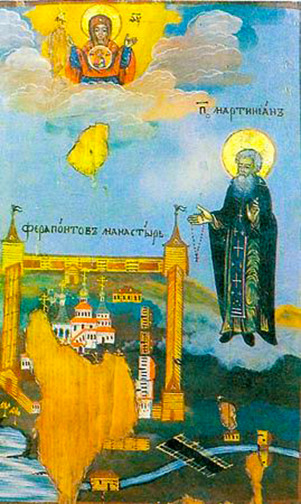
Saint Martinian of White Lake, in the world Michael, was born in the year 1370 in the village of Berezniko, not far from the Cyrilov monastery. At age thirteen he left his parents and went secretly to Saint Cyril of White Lake (June 9), whom many described as a great ascetic.
The young Martinian began zealously to imitate his teacher, with whom he dwelt in complete obedience. At the monastery he studied reading and writing, and with the blessing of Saint Cyril, he occupied himself with the copying of books. In time Martinian was ordained deacon and then hieromonk.
After the death of Saint Cyril (+ 1427), Martinian withdrew to a deserted island on Lake Vozha. Several monks gradually gathered around him. Saint Martinian established for them the church of the Transfiguration of the Lord and introduced a general Rule for the inhabitants. Yielding to the persistent requests of the brethren of Therapon monastery, he consented to become igumen of the monastery and brought it into an improved condition.
Saint Martinian gave spiritual support to Great Prince Basil in the difficulties of his time, when his first-cousin Demetrius Shemyaka illicitly sought the Moscow throne. He was always an advocate of truth and justice. Afterwards, upon the entreaty of the Great Prince, the saint accepted the governance of the monastery of Saint Sergius of Radonezh.
In 1455, Saint Martinian returned to the Therapon monastery. In his last years he was grievously ill and not able to walk, so the brethren carried him to church. He died at age 85. His relics were uncovered in the year 1514, and this event is celebrated on October 7.
THE NUN EUPRAXIA OF TABENYSSA (TABENEIA THE OLDER_ 393)

Saint Eupraxia was daughter of the Constantinople dignitary Antigonos, a kinsman of the holy Emperor Theodosius the Great (379-395).
Antigonus and his wife Eupraxia were pious and bestowed generous alms on the destitute. A daughter was born to them, whom they also named Eupraxia. Antigonos soon died, and the mother withdrew from the imperial court. She went with her daughter to Egypt, on the pretext of inspecting her properties. Near the Thebaid there was a women’s monastery with a strict monastic rule. The life of the inhabitants attracted the pious widow. She wanted to bestow aid on this monastery, but the abbess Theophila refused and said that the nuns had fully devoted themselves to God and that they did not wish the acquisition of any earthly riches. The abbess consented to accept only candles, incense and oil.
The younger Eupraxia was seven years old at this time. She liked the monastic way of life and she decided to remain at the monastery. Her pious mother did not stand in the way of her daughter’s wish. Taking leave of her daughter at the monastery, Eupraxia asked her daughter to be humble, never to dwell upon her noble descent, and to serve God and her sisters.
In a short while the mother died. Having learned of her death, the emperor Saint Theodosius sent Saint Eupraxia the Younger a letter in which he reminded her that her parents had betrothed her to the son of a certain senator, intending that she marry him when she reached age fifteen. The Emperor desired that she honor the commitment made by her parents. In reply, Saint Eupraxia wrote to the emperor that she had already become a bride of Christ, and she requested of the emperor to dispose of her properties, distributing the proceeds for the use of the Church and the needy.
Saint Eupraxia, when she reached the age of maturity, intensified her ascetic efforts all the more. At first she partook of food once a day, then after two days, three days, and finally, once a week. She combined her fasting with the fulfilling of all her monastic obediences. She toiled humbly in the kitchen, she washed dishes, she swept the premises and served the sisters with zeal and love. The sisters also loved the humble Eupraxia. But one of them envied her and explained away all her efforts as a desire for glory. This sister began to trouble and to reproach her, but the holy virgin did not answer her back, and instead humbly asked forgiveness.
The Enemy of the human race caused the saint much misfortune. Once,while getting water, she fell into the well, and the sisters pulled her out. Another time, Saint Eupraxia was chopping wood for the kitchen, and cut herself on the leg with an axe. When she carried an armload of wood up the ladder, she stepped on the hem of her garment. She fell, and a sharp splinter cut her near the eyes. All these woes Saint Eupraxia endured with patience, and when they asked her to rest, she would not consent.
For her efforts, the Lord granted Saint Eupraxia a gift of wonderworking. Through her prayers she healed a deaf and dumb crippled child, and she delivered a demon-possessed woman from infirmity. They began to bring the sick for healing to the monastery. The holy virgin humbled herself all the more, counting herself as least among the sisters. Before the death of Saint Eupraxia, the abbess had a vision. The holy virgin was transported into a splendid palace, and stood before the Throne of the Lord, surrounded by holy angels. The All-Pure Virgin showed Saint Eupraxia around the luminous chamber and said that She had made it ready for her, and that she would come into this habitation after ten days.
The abbess and the sisters wept bitterly, not wanting to lose Saint Eupraxia. The saint herself, in learning about the vision, wept because she was not prepared for death. She asked the abbess to pray that the Lord would grant her one year more for repentance. The abbess consoled Saint Eupraxia and said that the Lord would grant her His great mercy. Suddenly Saint Eupraxia sensed herself not well, and having sickened, she soon peacefully died at the age of thirty.


MARK 10:2-12
2 The Pharisees came and asked Him, "Is it lawful for a man to divorce his wife?" testing Him. 3 And He answered and said to them, "What did Moses command you?" 4 They said, "Moses permitted a man to write a certificate of divorce, and to dismiss her." 5 And Jesus answered and said to them, "Because of the hardness of your heart he wrote you this precept. 6 But from the beginning of the creation, God 'made them male and female.' 7For this reason a man shall leave his father and mother and be joined to his wife, 8 'and the two shall become one flesh'; so then they are no longer two, but one flesh. 9 Therefore what God has joined together, let not man separate. 10 In the house His disciples also asked Him again about the same matter. 11 So He said to them, "Whoever divorces his wife and marries another commits adultery against her. 12 And if a woman divorces her husband and marries another, she commits adultery.
HEBREWS 12:25-26; 13:22-25
25 See that you do not refuse Him who speaks. For if they did not escape who refused Him who spoke on earth, much more shall we not escape if we turn away from Him who speaks from heaven,26 whose voice then shook the earth; but now He has promised, saying, "Yet once more I shake not only the earth, but also heaven." 22 And I appeal to you, brethren, bear with the word of exhortation, for I have written to you in few words.23 Know that our brother Timothy has been set free, with whom I shall see you if he comes shortly.24 Greet all those who rule over you, and all the saints. Those from Italy greet you. 25 Grace be with you all. Amen.
#orthodoxy#orthodoxchristianity#originofchristianity#spirituality#holyscriptures#gospel#bible#wisdom
3 notes
·
View notes
Text
Joan of Arc and Mark Twain
Mark Twain wrote, “I like Joan of Arc best of all my books; and it is the best; I know it perfectly well. And besides, it furnished me seven times the pleasure afforded me by any of the others; twelve years of preparation, and two years of writing. The others needed no preparation and got none.”
Twain was passionate about historical accuracy when writing about Joan of Arc, and he learned French to read available documentation about her life. His notebooks from 1855 are full of French language exercises that illustrate the painstaking process he used to learn the language. By 1860 Twain was reading Voltaire, and when his book about Joan of Arc was published in 1896, he listed 11 academic sources to bolster his claims about the accuracy of details included in his book.
In the transcripts from Joan of Arc’s 1431 Condemnation Trial, she provides meticulous details about having supernatural encounters with long-dead Catholic saints. She claimed to hear the voices of these saints daily, and she provided other details about having visual encounters with apparitions of the saints.
Scholarly debate continues to this day on the source of Joan’s “voices” (the mysterious interior locutions that guided her behavior). Some say Joan suffered from delusions, but she claimed her voices gave her the instructions that led to her military success. She also stated numerous times that her voices enabled her to make accurate predictions about future events—which were confirmed by many witnesses who gave testimony during Joan’s 1455 Rehabilitation Trial.
Twain’s interest in supernatural and paranormal phenomena began in the 1840s when twice he witnessed his mother’s recovery after the intervention of a faith healer. Twain also had a dream in which he saw a future event—his brother dead, lying in a coffin. The dream was full of details that later proved to be entirely accurate, down to details such as a single red rose laying in the middle of a bouquet of white flowers.
After those events, Twain began having experiences he described as “thought transfer,” and he joined the London Society for Psychical Research in 1885. During the twelve years of research Twain did in preparing to write about Joan of Arc, he became enthralled with Joan and her supernatural experiences, all of which are documented in her trial transcripts.
When Twain was the guest of honor during a 1905 dinner attended by Andrew Carnegie, organizers of the event planned to surprise Twain by having a woman appear as Joan of Arc. The following quote is from a New York Times article published December 22, 1905, “Joan of Arc Appears to Startle Mark Twain—Surprise Prepared for Him by Society of Illustrators.”
“It had been arranged that when the humorist arose to speak, Miss Angersten, a well-known model, was to appear in the garb and with the simple dignity of Jean d’Arc, his favorite character in all history. He was on his feet as Jean d’Arc entered the room. She wore the armor of the French heroine and her hair and face made a strangely appealing picture. The face of the humorist, which had been wearing its ‘company’ smile all night, suddenly changed. He had every appearance of a man who had seen a ghost. His eyes fairly started out of his head, and his hand gripped the edge of the table. …The humorist looked toward the door, and there was absolute silence—puzzled silence—for many did not know whether it was time to laugh, disrespectful to giggle, or discourteous to keep solemn.”
Today, May 30, is Joan of Arc’s feast day in the Catholic Church, marking the anniversary of the day she was burned at the stake in Rouen, France, in 1431. She led thousands of men in military battles that were decisive in ending the Hundred Years War, and she was officially appointed as commander-in-chief of the French army by King Charles VII, but he later abandoned her when he could have intervened to save her from execution.
During Joan’s Condemnation Trial in 1431, which lasted from January 9 until May 30, Guillaume Manchon, a notary, produced the trial transcripts in a language referred to as Medieval/Middle French, with oversight and assistance from two other notaries, Guillaume Colles and Nicolas Taquel.
Later, Manchon and one of the trial judges, Thomas de Courcelles, translated the Middle French into Latin and five handwritten copies were made. One copy was sent to Rome, three copies are in Paris, and one copy was destroyed ceremoniously in 1456 at the conclusion of a Rehabilitation Trial, which nullified the verdict of the Condemnation Trial.
The first unabridged translations of those original Latin transcripts were published in modern French in 1841 by Jules Étienne Joseph Quicherat and in English in 1932 by W.P. Barrett. A shorter, abridged version produced by Emilia P. Sanguinetti—which is included with this book by Mark Twain—was translated and edited using those two unabridged translations and Pierre Champion’s “Procès de Condamnation de Jeanne d’Arc, Texte, Traduction et Notes,” published in 1921.
Emilia P. Sanguinetti is the author and translator of the book, “Joan of Arc: Her Trial Transcripts.” She has five years of formal French language training and her translation of Joan of Arc’s trial transcripts is included with this publication of Mark Twain’s book: https://www.amazon.com/dp/B019BCELHK
8 notes
·
View notes
Text
12th King of Portugal (3rd of the Aviz Dynasty), King Afonso V of Portugal, “The African”
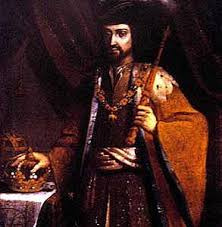
Reign: 13 September 1438 – 28 August 1481
Acclamation: 15 January 1446
Predecessor: Duarte I
Afonso V (15 January 1432 – 28 August 1481), known by the sobriquet the African (o Africano), was King of Portugal. His sobriquet refers to his conquests in Northern Africa.
As of 1471, Afonso V was the first king of Portugal to claim dominion over a plural "Kingdom of the Algarves", instead of the singular "Kingdom of the Algarve". Territories added to the Portuguese crown lands in North Africa during the 15th century came to be referred to as possessions of the Kingdom of the Algarve (now a region of southern Portugal), not the Kingdom of Portugal. The "Algarves" then were considered to be the southern Portuguese territories on both sides of the Strait of Gibraltar.

Afonso was born in Sintra, the second son of King Duarte of Portugal by his wife Leonor of Aragon. Following the death of his older brother, Infante João (1429-1433), Afonso acceded to the position of heir apparent and was made the first Prince of Portugal by his father, who sought to emulate the English Court's custom of a dynastic title that distinguished the heir apparent from the other children of the monarch. He was only six years old when he succeeded his father in 1438.
During his minority, Afonso V was placed under the regency of his mother in accordance with a will of his late father. As both a foreigner and a woman, the queen was not a popular choice for regent. Opposition rose and without any important ally among the Portuguese aristocracy other than Afonso, Count of Barcelos, the illegitimate half brother of King Duarte, the queen's position was untenable. In 1439, the Portuguese Cortes (assembly of the kingdom) decided to replace the queen with Pedro, Duke of Coimbra (Dom Pedro), the young king's oldest uncle.
Pedro's main policies were concerned with restricting the political power of the great noble houses and expanding the powers of the crown. The country prospered under his rule, but not peacefully, as his laws interfered with the ambition of powerful nobles. The count of Barcelos, a personal enemy of the Duke of Coimbra (despite being half-brothers) eventually became the king's favourite uncle and began a constant struggle for power. In 1442, the king made Afonso the first Duke of Braganza. With this title and its lands, he became the most powerful man in Portugal and one of the richest men in Europe. To secure his position as regent, Pedro had Afonso marry his daughter, Isabel of Coimbra, in 1445.
But on 9 June 1448, when the king came of age, Pedro had to surrender his power to Afonso V. The years of conspiracy by the Duke of Braganza finally came to a head. On 15 September of the same year, Afonso V nullified all the laws and edicts approved under the regency. In the following year, led by what were later discovered to be false accusations, Afonso declared Pedro a rebel and defeated his army in the Battle of Alfarrobeira,
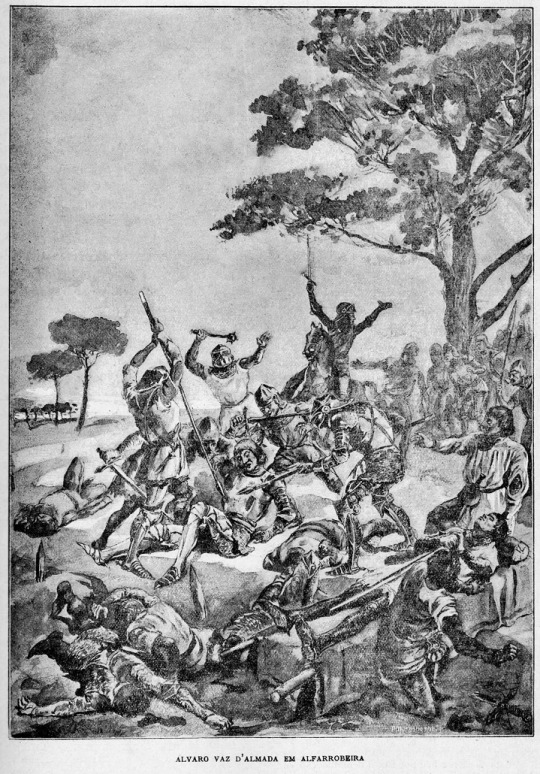
in which his uncle (and father-in-law) was killed. After this battle and the loss of one of Portugal's most remarkable infantes, the Duke of Bragança became the de facto ruler of the country.

Afonso V then turned his attentions to North Africa. In the reign of his grandfather João I, Ceuta had been conquered from the king of Morocco, and now the new king wanted to expand the conquests. The king's army conquered Alcácer Ceguer in 1458 and Arzila in 1471.

Tangiers, on the other hand, was won and lost several times between 1460 and 1464. These achievements granted the king the nickname of the African or Africano.
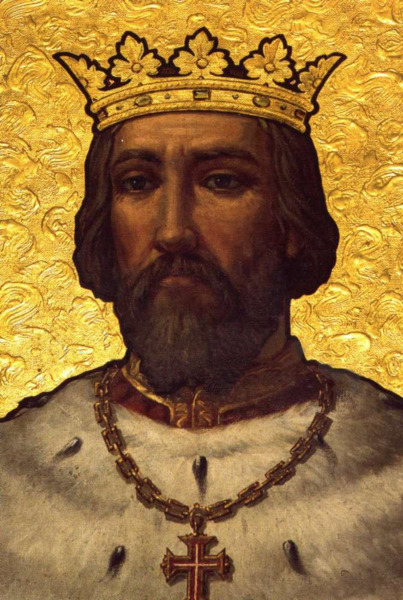
The king also supported the exploration of the Atlantic Ocean led by prince Henrique the Navigator but after Henrique's death in 1460, he did nothing to continue Henrique's work. Administratively, Afonso V was a passive king. He chose not to pursue the revision of laws or development of commerce, preferring instead to preserve the legacy of his father Duarte and grandfather João I.
In 1452, Pope Nicholas V issued the papal bull Dum Diversas, which granted Afonso V the right to reduce "Saracens, pagans and any other unbelievers" to hereditary slavery. This was reaffirmed and extended in the Romanus Pontifex bull of 1455 (also by Nicholas V). These papal bulls came to be seen by some as a justification for the subsequent era of slave trade and European colonialism.

When the campaigns in Africa were over, Afonso V found new grounds for battle in neighboring Castile. On December 11, 1474 King Henry IV of Castile

died without a male heir, leaving just one daughter, Joanna la Beltraneja.

However, her paternity was questioned; it was rumored that his wife, Queen Joana of Portugal
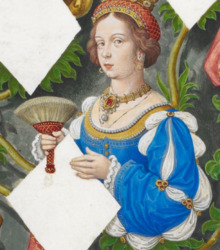
had an affair with a nobleman named Beltrán de La Cueva.
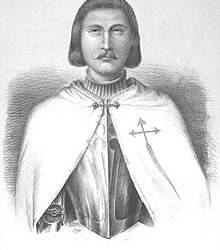
The death of Henry ignited a war of succession with one faction supporting Joana and the other supporting Isabel, Henry's half-sister.

Afonso V was persuaded to intervene on behalf of Joana, his niece. He betrothed himself to her, proclaimed himself king of Castile and led troops into the kingdom. Because of their close blood-relationship, a formal marriage had to wait for papal dispensation.
On May 12, 1475, Afonso entered Castile with an army of 5,600 cavalry and 14,000 foot soldiers. In March, 1476, after several skirmishes and much maneuvering, the 8, 000 men of Afonso and Prince João,
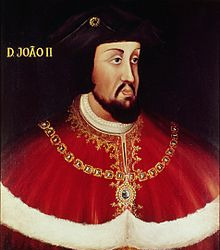
faced a Castilian force of similar size in the battle of Toro.
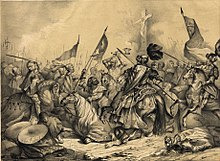
The Castilians were led by Isabella's husband, Prince Fernando II of Aragon
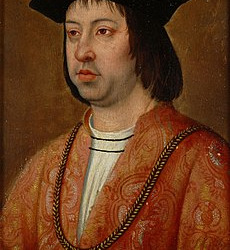
Cardinal Mendoza and the Duke of Alba. The fight was fierce and confusing but the result was a stalemate: While the forces of Cardinal Mendoza and the Duke of Alba won over their opponents led by the Portuguese King –who left the battlefield to take refuge in Castronuño, the troops commanded by Prince João defeated and persecuted the troops of the Castilian right wing, recovered the Portuguese royal standard, remaining ordered in the battlefield where they collected the fugitives of Afonso. Both sides claimed victory but Afonso's prospects for obtaining the Castilian crown were severely damaged.
“It was March 1, 1476. Eight thousand men for each side, the chronicles tell. With Afonso of Portugal were his son João and the bishops of Evora and Toledo. With Fernando of Aragón, Cardinal Mendoza and the Duke of Alba, as well as the militias of Zamora, Ciudad Rodrigo and Valladolid. The battle was long, but not especially bloody: it is estimated that the casualties of each side did not reach a thousand. Who won? In reality, no one: Afonso's wing of Portugal fell under the thrust of Fernando, but Prince João's troops crushed their Castilian rivals. However, victory in this battle was not going to be military, but ... political. In fact, Fernando of Aragon, seeing that the clash concluded without winners or losers, hastened to give his own version of the facts. He sent letters to all the cities of Castile and Aragon and to several European courts.”
After the battle, Afonso sailed to France hoping to obtain the assistance of King Louis XI

in his fight against Castile. But finding himself deceived by the French monarch, he returned to Portugal in 1477. Disillusioned, he abdicated for a few days in November 1477 in favor of his son João II, then after returning to the throne, he retired to a monastery in Sintra, where he died in 1481. He rests with his first wife Queen Isabel of Coimbra in the Founder’s Chapel, inside the Monastery of Batalha.
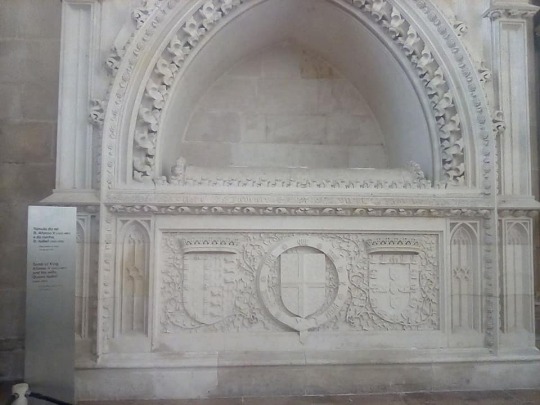
Afonso married firstly, in 1447, Isabel of Coimbra, with whom he had three children:
João, Prince of Portugal (29 January 1451). He his buried in the Unfinished Chapels in the Monastery of Batalha next to his grandparents King Duarte of Portugal and Queen Leonor de Aragão.

Joana, Princess of Portugal (6 February 1452 – 12 May 1490): Known as Saint Joana of Portugal or Saint Joana Princess.
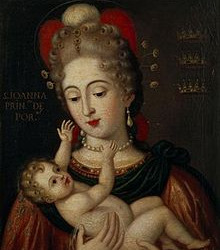
João II of Portugal (3 March 1455 – 25 October 1495): Succeeded his father as 13th King of Portugal.
Afonso married secondly, in 1475, his niece Joanna of Castile, known as "La Beltraneja".
7 notes
·
View notes
Text
cricket score West Indies vs England
West Indies :- 224/5
England :- (20 ov, target 225) 204/9
MATCH DETAILS
Kensington Oval, Bridgetown, Barbados
Toss :- England, elected to field first
Series :- England tour of West Indies
Season :- 2021/22
Player Of The Match :- Rovman Powell
Match number T20I no:- 1455
Match days :- 26 January 2022 – daynight (20-over match)
T20I Debut :- George Garton , Harry Brook ,Phil Salt
Read More
0 notes
Photo

Saint of the Day – 18 February – Blessed John of Fiesole/Fra Angelico O.P. (1387-1455) Born in 1387 in Vicchio di Mugello near Florence, Italy as Guido di Pietro – he died on 18 February 1455 in the Dominican convent in Rome, Italy of natural causes. He was known to contemporaries as Fra Giovanni da Fiesole (Brother John of Fiesole) and Fra Giovanni Angelico (Angelic Brother John). In modern Italian he is called il Beato Angelico (Blessed Angelic One); the common English name Fra Angelico means the “Angelic friar”. In 1982, Pope John Paul II proclaimed his beatification in recognition of the holiness of his life, thereby making the title of “Blessed” official. Fiesole is sometimes misinterpreted as being part of his formal name but it was merely the name of the town where he took his vows as a Dominican friar and was used by contemporaries to separate him from others who were also known as Fra Giovanni. He is listed in the Roman Martyrology as Beatus Ioannes Faesulanus, cognomento Angelicus—”Blessed Giovanni of Fiesole, surnamed ‘the Angelic’ “. Patron of Catholic Artists.

Fra Angelico was an Early Italian Renaissance painter described by Vasari in his Lives of the Artists as having “a rare and perfect talent”.
Early life, 1395–1436
Fra Angelico was born Guido di Pietro at Rupecanina in the Tuscan area of Mugello near Fiesole towards the end of the 14th century. Nothing is known of his parents. He was baptised Guido or Guidolino. The earliest recorded document concerning Fra Angelico dates from 17 October 1417 when he joined a religious confraternity or guild at the Carmine Church, still under the name of Guido di Pietro. This record reveals that he was already a painter, a fact that is subsequently confirmed by two records of payment to Guido di Pietro in January and February 1418 for work done in the church of Santo Stefano del Ponte. The first record of Angelico as a friar dates from 1423, when he is first referred to as Fra Giovanni (Friar John), following the custom of those entering one of the older religious orders of taking a new name. He was a member of the local community at Fiesole, not far from Florence, of the Dominican Order; one of the medieval Orders belonging to a category known as mendicant Orders because they generally lived not from the income of estates but from begging or donations. Fra, a contraction of frater (Latin for ‘brother’), is a conventional title for a mendicant friar.
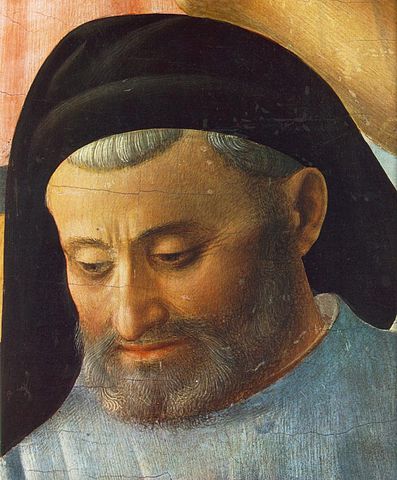
According to Vasari, Fra Angelico initially received training as an illuminator, possibly working with his older brother Benedetto who was also a Dominican and an illuminator. The former Dominican convent of San Marco in Florence, now a state museum, holds several manuscripts that are thought to be entirely or partly by his hand. The painter Lorenzo Monaco may have contributed to his art training and the influence of the Sienese school is discernible in his work. He had several important charges in the convents he lived in but this did not limit his art, which very soon became famous. According to Vasari, the first paintings of this artist were an altarpiece and a painted screen for the Charterhouse (Carthusian monastery) of Florence; none such exist there now.
From 1408 to 1418, Fra Angelico was at the Dominican friary of Cortona, where he painted frescoes, now mostly destroyed, in the Dominican Church and may have been assistant to Gherardo Starnina or a follower of his. Between 1418 and 1436 he was at the convent of Fiesole, where he also executed a number of frescoes for the church and the Altarpiece, which was deteriorated but has since been restored. A predella of the Altarpiece remains intact and is conserved in the National Gallery, London, and is a great example of Fra Angelico’s ability. It shows Christ in Glory surrounded by more than 250 figures, including beatified Dominicans.
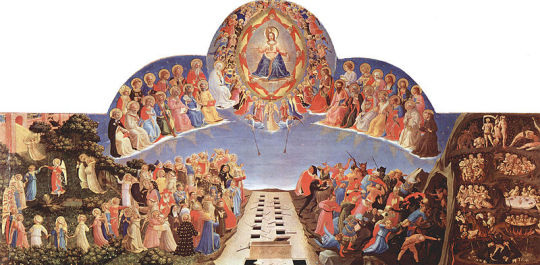
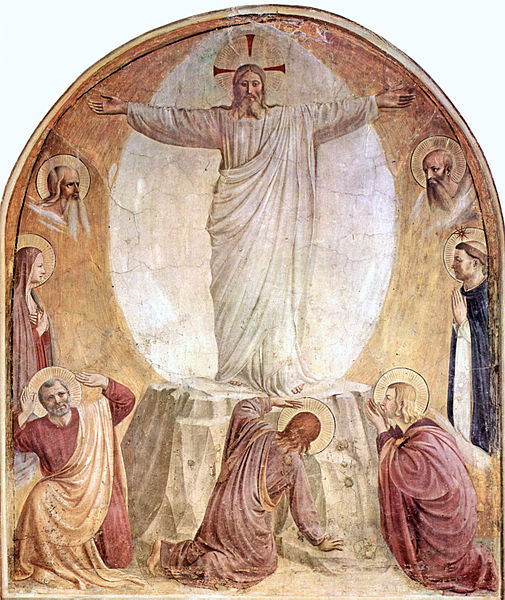
The Last Judgement and The Transfiguration shows the directness, simplicity and restrained palette typical of these frescoes. Located in a monk’s cell at the Convent San’ Marco and intended for private devotion.
San Marco, Florence, 1436–1445
In 1436, Fra Angelico was one of a number of the friars from Fiesole who moved to the newly built convent or friary of San Marco in Florence. This was an important move which put him in the centre of artistic activity of the region and brought about the patronage of one of the wealthiest and most powerful members of the city’s governing authority, or “Signoria” (namely Cosimo de’ Medici), who had a cell reserved for himself at the friary in order that he might retreat from the world.
It was, according to Vasari, at Cosimo’s urging that Fra Angelico set about the task of decorating the convent, including the magnificent fresco of the Chapter House, the often-reproduced Annunciation at the top of the stairs leading to the cells, the Maesta (or Coronation of the Madonna) with Saints (cell 9) and the many other devotional frescoes, of smaller format but remarkable luminous quality, depicting aspects of the Life of Christ that adorn the walls of each cell.
In 1439 Fra Angelico completed one of his most famous works, the San Marco Altarpiece at Florence. The result was unusual for its time. Images of the enthroned Madonna and Child surrounded by saints were common, but they usually depicted a setting that was clearly heaven-like, in which saints and angels hovered about as divine presences rather than people. But in this instance, the saints stand squarely within the space, grouped in a natural way as if they were able to converse about the shared experience of witnessing the Virgin in glory. Paintings such as this, known as Sacred Conversations, were to become the major commissions of Giovanni Bellini, Perugino and Raphael.

San Marco Altarpiece
The Vatican, 1445–1455
In 1445 Pope Eugene IV summoned him to Rome to paint the frescoes of the Chapel of the Holy Sacrament at St Peter’s, later demolished by Pope Paul III. Vasari claims that at this time Fra Angelico was offered the Archbishopric of Florence by Pope Nicholas V and that he refused it, recommending another friar for the position. The story seems possible and even likely. However, if Vasari’s date is correct, then the pope must have been Eugene IV and not Nicholas, who was elected Pope only on 6 March 1447. Moreover, the archbishop in 1446–1459 was the Dominican Antoninus of Florence (Antonio Pierozzi), canonised by Pope Adrian VI in 1523. In 1447 Fra Angelico was in Orvieto with his pupil, Benozzo Gozzoli, executing works for the Cathedral. Among his other pupils were Zanobi Strozzi.
From 1447 to 1449 Fra Angelico was back at the Vatican, designing the frescoes for the Niccoline Chapel for Nicholas V. The scenes from the lives of the two martyred deacons of the Early Christian Church, St Stephen and St Lawrence may have been executed wholly or in part by assistants. The small chapel, with its brightly frescoed walls and gold leaf decorations gives the impression of a jewel box. From 1449 until 1452, Fra Angelico returned to his old convent of Fiesole, where he was the Prior.
Death and beatification
In 1455, Fra Angelico died while staying at a Dominican convent in Rome, perhaps on an order to work on Pope Nicholas’ chapel. He was buried in the church of Santa Maria sopra Minerva.
When singing my praise, don’t liken my talents to those of Apelles.
Say, rather, that, in the name of Christ, I gave all I had to the poor.
The deeds that count on Earth are not the ones that count in Heaven.
I, Giovanni, am the flower of Tuscany.
— Translation of epitaph
The English writer and critic William Michael Rossetti wrote of the friar:
“From various accounts of Fra Angelico’s life, it is possible to gain some sense of why he was deserving of canonisation. He led the devout and ascetic life of a Dominican friar and never rose above that rank; he followed the dictates of the order in caring for the poor; he was always good-humoured. All of his many paintings were of divine subjects and it seems that he never altered or retouched them, perhaps from a religious conviction that, because his paintings were divinely inspired, they should retain their original form. He was wont to say that he who illustrates the acts of Christ should be with Christ. It is averred that he never handled a brush without fervent prayer and he wept when he painted a Crucifixion. The Last Judgement and the Annunciation were two of the subjects he most frequently treated.”

The Crucified Christ
Pope John Paul II beatified Fra Angelico on 3 October 1982 and in 1984 declared him patron of Catholic artists.
“Angelico was reported to say “He who does Christ’s work must stay with Christ always”. This motto earned him the epithet “Blessed Angelico” because of the perfect integrity of his life and the almost divine beauty of the images he painted, to a superlative extent those of the Blessed Virgin Mary.”— St Pope John Paul II


(via AnaStpaul – Breathing Catholic)
33 notes
·
View notes
Text
How Do Courts Treat Notice Periods for Terminated Employees During the Pandemic?

"At this time last year many wondered how the unprecedented economic circumstances created by the pandemic would affect reasonable notice periods awarded to employees terminated during the pandemic. A year on, and as cases of terminated employees have made their way through the court system, it seems the answer is clear: the pandemic may be a factor to consider in determining reasonable notice, but not to the exclusion of others and only to the extent that it existed as a factor at the time of the termination."
"In Canada, an employee is entitled to reasonable notice of termination unless otherwise stipulated in a valid employment contract. The appropriate duration of a reasonable notice depends on all the circumstances, including but not limited to the employee’s age, length of service, the nature of the position and the availability of similar employment. Prior to the pandemic, courts were already clear that 'economic factors' in the market or in a particular sector or industry that make it difficult for a terminated employee to find another position may justify a longer notice period. On this basis, many employees, and more specifically their counsel, have argued the pandemic has created an economic reality that justifies imposing a lengthier notice period."
"In Iriotakis v Peninsula Employment Services Limited, ... the Superior Court of Ontario noted the pandemic was likely to have a negative impact on the plaintiff’s job search and concluded that the parties ought to have reasonably expected it to have such an impact when his employment was terminated in late March 2020. However, while COVID-19 was a factor in assessing the notice period, the court did not consider it to the exclusion of all others, instead calling for a balanced approach that considered all relevant factors. ... In Yee v Hudson’s Bay Company, the Ontario Superior Court considered the case of a management employee terminated in August of 2019, prior to the pandemic. The plaintiff argued the economic conditions caused by the pandemic made it more difficult to find a new job and therefore justified the imposition of a lengthier notice period. The court refused to do so, ultimately holding the appropriate notice period is to be determined based on the circumstances that existed at the time of termination. The Ontario Superior Court reached a similar decision in Nahum v Honeycomb Hospitality Inc., where the court did not give weight to the pandemic since the employee was terminated before its onset."
"Thus, the economic downturn caused by the pandemic will only be considered in assessing reasonable notice periods where it was within the reasonable contemplation of the parties at the time of termination. Otherwise, it may only be considered for assessing mitigation efforts, as courts have concluded that the pandemic is a factor that is likely to make finding a job more difficult."
Norton Rose Fulbright, April 16, 2021: "How do courts treat notice periods for terminated employees during the pandemic?," by Joseph Cohen-Lyons and Conrad Flaczyk
CanLII, February 9, 2021: Iriotakis v. Peninsula Employment Services Limited, 2021 ONSC 998 (13 pages, PDF)
CanLII, January 18, 2021: Yee v Hudson’s Bay Company, 2021 ONSC 387 (9 pages, PDF)
CanLII, February 26, 2021: Nahum v. Honeycomb Hospitality Inc., 2021 ONSC 1455 (10 pages, PDF)
Photo Source: (2021). Employment And Labour Employee Walking [Photograph]. Norton Rose Fulbright. https://www.nortonrosefulbright.com/-/media/images/nrf/thought-leadership/canada/publications/employment-and-labour-employee-walking.jpg
#pandemic#COVID-19#termination notice periods#terminated employees#reasonable notice#wrongful dismissals#superior court of ontario#case law
0 notes
Text
Scale of Dragon, Tooth of Wolf: ASOIAF and the Wars of the Roses
The hardest thing about writing this meta was literally, where to begin? I will apologize in advance, as I will try to keep my thoughts as tidy and streamlined as possible, but I have a lot to cover and do tend to run away with my words at times. This is a collaborative meta of sorts, as I drew insight, inspiration and help in constructing this massive baby from the wonderful @thewesterwoman (who also contributed parts of it, as noted within).
So, I suppose we’ll start where I begun. A few weeks ago, I stumbled onto this meta about Jamie Lannister and how he may actually be TPTWP. Now, before you shrug that off, I suggest you read this:
https://thewesterwoman.tumblr.com/post/163650220053/azor-ahai-and-the-matter-of-jaime-irony-and
And while you’re at it, make sure you give @thewesterwoman a follow because her brilliant analytical mind is a blessing to this fandom. Yes, she even ships Jonsa (but less flailing and more logic). 😉
After reading her meta, I was definitely intrigued, so I began some research of my own, and this theory is actually a lot more popular (especially with book readers) than you may think. It prompted me to send her this ask:
https://thewesterwoman.tumblr.com/post/163779372473/so-if-you-think-that-jamie-may-be-the-one-who
Her answer only served to intrigue me more, and we struck up a private convo discussing all the War of the Roses similarities, and how GoT might actually come to its bittersweet end -and so this meta was born. It will be part tinfoil/part actual history. Let’s begin.
What’s in a Name?
So with that said, let us first focus on the last three major houses left in GoT: the Lannisters, the Starks and the Targaryens -and the three* major players of the War of the Roses: the Lancasters, the Yorks and the Tudors. Marinate on that a minute. Okay? Good. Here’s what you should have came up with:
Lancasters/Lannisters
Yorks/Starks
Tudor (Plantagenet)/Targaryen *
*History shows us that the War of the Roses actual main players were the Lancasters and Yorks, but for all of you who are not historian buffs (me), they both descended from the same royal house: Plantagenet and ended with Tudor. Think of them as Alpha and Omega.* Oh, and wouldn’t you know -what an incestuous web they wove, but that’s a meta for another day. 😂
As per Wikipedia (and because I’m lazy):
The House of Plantagenet (/plænˈtædʒᵻnᵻt/) was a royal house which originated from the lands of Anjou in France. The name Plantagenet is used by modern historians to identify four distinct royal houses – the Angevins who were also Counts of Anjou, the main body of the Plantagenets following the loss of Anjou, and the houses of Lancaster and York, the Plantagenets’ two cadet branches. The family held the English throne from 1154, with the accession of Henry II, until 1485, when Richard III died.
One other thought ( @thewesterwoman adds )- as many have noted, Westeros is obviously a continent-sized, fantasy-version of Britain (with the North more or less standing in for Scotland). Westerosi history is similarly based on British history, which saw several waves of migration from foreign invaders that greatly resembles the Westerosi invasions by the First Men, the Andals, and finally the Targaryens.
The Targaryens in particular seem to represent the Norman invasion of England, which was led by William the Conqueror, who I take for a direct analogue to Westeros’s own Aegon the Conqueror (a foreign invader who united several warring kingdoms into one country under his reign). This is relevant to our theory because the royal English House of Plantagenet (and thus the House of Tudor as well) is more or less directly descended from the dynasty founded by William the Conqueror, just as the Targaryens are from Aegon the Conqueror.
Amidst the War a King is Born
As you all know, the War of Roses was put to an end by Henry Tudor, or King Henry VII -also known as the first King of the Tudor line. I’m not going to dive fully into his entire biography -just the parts/similarities that fit in the GoT narrative.
The War of the Roses broke out prior to his birth on May 22, 1455 and Henry was born on January 28, 1457 -the son of Lady Margaret Beaufort, and Edmund Tudor, first Earl of Richmond (half brother to King Henry VI). Edmund, a Lancastrian, was taken prisoner by Yorkist forces mere months after his marriage to Margaret, and died in captivity less than a year later, leaving behind a 13-year-old widow who was seven months pregnant with their child -whom she birthed at the tender age of 14.
This sounds vaguely familiar -like a lovable bastard prince we know, who’s mother birthed him at a tender age, his father dying in a “rebellion” of sorts -War of the Roses/Roberts Rebellion. But wait -the similarities don’t end there. While Margaret didn’t die like Lyanna -Henry would be her only child. The birth was described as “particularly difficult; at one point, both the Countess and her child were close to death, due to her young age and small size”. She never gave birth again. After his father’s death, Margaret and Henry were taken in by Edmunds brother Jasper (Henry’s uncle), the Duke of Pembroke.
Now here’s where it gets tricky … because I’m about to split Henry’s upbringing into two parts, or rather -two characters: Jon Snow and Danaerys Targaryen.
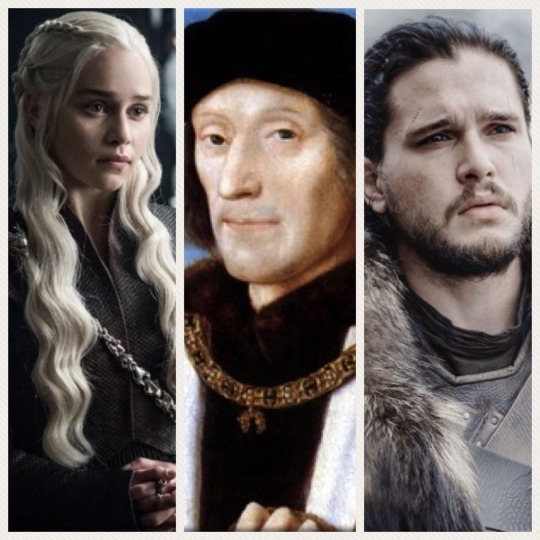
Jon Snow:
When Edward IV became the first Yorkist King in 1461, Jasper fled abroad and Castle Pembroke, along with the Earldom were given over to the Yorkist, William Herbert -who then took over guardianship of the 4 year old Henry and his mother. Henry lived in the Herbert household until 1469 (he was 12) when more York/Lancaster drama ensued and Henry VI reclaimed his throne.
Daenerys Targaryen:
At some point, fearing her son’s safety, Margaret sent Henry into exile with his uncle Jasper -where he remained, garnering French and Welsh support before returning to lay a claim to the throne. When Henry Tudor invaded England, his army consisted of French mercenaries and Welsh warriors – which would be considered a largely foreign group (foreign invaders -Dothraki and the Unsullied).
So, you see how in comparison to Henry’s early life, we could easily divide aspects of it between both Jon and Dany. Being raised by an uncle, being exiled for safety, garnering foreign support and returning to claim their “birthright”. It’s also important to note that with his father dying prior to his birth, Henry fought claims of illegitimacy (bastard) for most of his life.
A Dragon and a Prophecy
Henry also made some political capital out of his Welsh ancestry, attracting military support and safeguarding his army’s passage through Wales on his way to the Battle of Bosworth. He came from an old, established Anglesey family that claimed descent from Cadwaladr (a Welsh King depicted in legend, the last ancient British king), and on occasion Henry displayed that Welsh standard.
That Welsh standard Henry fought and conquered under? Well I’m glad you asked … The flag of Wales (Welsh: Baner Cymru or Y Ddraig Goch, meaning the red dragon) .

A red dragon! You don’t say? Where have we seen that before? Oh, right …the Targaryen house sigil.
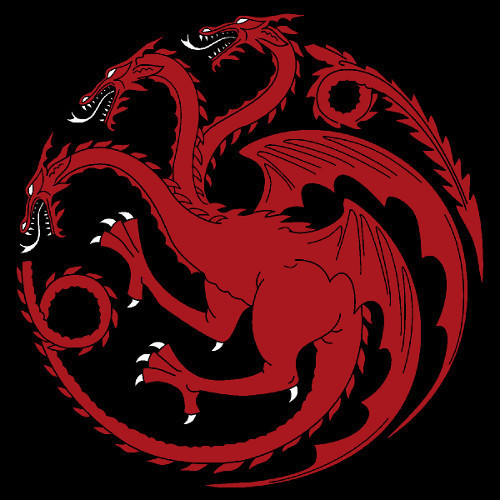
But Henry’s welsh dragon isn’t just ANY dragon, but -a dragon that’s attached to a prophecy: Y Mab Darogan.
From Wikipedia (again because I’m lazy):
Y Mab Darogan (pronounced [ə mɑːb darɔˈɡan] meaning “The Destined/Prophesised Son” or “Son of Destiny”) is a messianic figure of Welsh legend, destined to force the English out of Britain and reclaim it for its Celtic inhabitants. A number of figures have been called Y Mab Darogan in history (other titles include Y Gŵr Darogan and Y Daroganwr). An extensive corpus of medieval Welsh prophetic verse, beginning with Armes Prydain (10th century?), is centred on the figure of Y Mab Darogan.
A prince who was promised? Ya don’t say?!?!
Several historical figures have thought to have been this “Son of Destiny” -even King Arthur of Camelot. With poets and supporters labeling Henry the prophesied prince, it certainly didn’t hurt in strengthening his claim to the throne. Later, his reign over England was believed to be the prophecy fulfilled -a belief that he encouraged by naming his firstborn son Arthur.
Two Roses become One
As most of you know, Henry later wed Elizabeth of York. They were third cousins -both great-great grandchildren of John of Gaunt. The marriage unified the two warring houses and gave any of their future children strong claims to the throne. The unification of the houses of York and Lancaster by this marriage is symbolised by the Tudor Rose -a combination of the white rose of York and the red rose of Lancaster.

*Remember this, because we’ll come back to this later when I make my endgame predictions.
I would also like to present to you, the Tudor house Coat of Arms (under Henry VII and the first half of his son, Henry VIII’s reign):
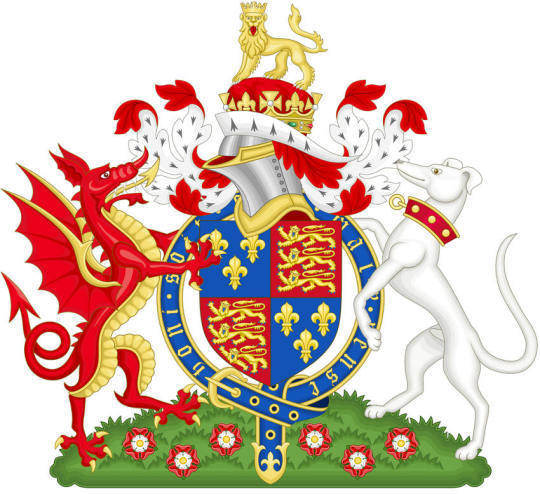
A red dragon, a white dog (wolf) and a golden lion sitting atop the crest, amid the Tudor roses.
As Alice (in Wonderland) would say: Curiouser and curiouser ….
The White Rose (of Winterfell?)

A red-headed beauty -Elizabeth of York was described as fair of hair and face. The eldest child, she had two younger brothers (known as the Princes in the Tower) who disappeared shortly after her father’s death -thought to be murdered by her uncle.
From Wikipedia (and you guessed it, because I’m lazy):
“The Princes in the Tower” is an expression frequently used to refer to Edward V, King of England and Richard of Shrewsbury, Duke of York. The two brothers were the only sons of Edward IV of England and Elizabeth Woodville surviving at the time of their father’s death in 1483. When they were 12 and 9 years old, respectively, they were lodged in the Tower of London by the man appointed to look after them, their uncle, the Lord Protector: Richard, Duke of Gloucester. This was supposedly in preparation for Edward’s forthcoming coronation as king. However, Richard took the throne for himself and the boys disappeared.
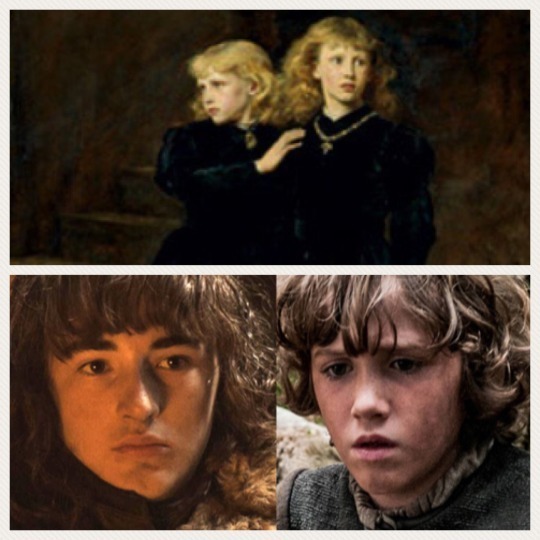
Compare this if you’d like, to Sansa’s brothers Bran and Rickon “disappearing” -first thought to be murdered by Theon, then Rickon actually being murdered, and Bran essentially dying as well, now that he’s the 3 eyed Raven. This may be a bit tin foilish, but Bran was also pushed from a Tower -which sent the whole chain of events in motion.
Despite being a political arrangement at first, the marriage between Henry and Elizabeth proved successful and both partners appear to have grown to love each other. Jon and Sansa have already proven to share a powerful loving bond rooted in trust.
But wait!
Aren’t the Starks (Yorks) supposed to be the good guys, and the Lannisters (Lancasters) the bad? I’m glad you asked, and I’ll hand you over to @thewesterwoman for that …
When it comes to the Wars of the Roses, one side - the Lancasters - has traditionally been presented in a far more positive light than the other - the Yorks. This is because the Tudor dynasty which ultimately emerged the victor of the war was descended in the male line from the Lancasters, making them the ‘winning’ side. As such, the vast majority of primary sources from after the war paint the Lancasters in a flattering light and the Yorks in a negative one, in an effort on the part of their writers to gain favor with the current reigning monarchs of England.
Today, this is especially noticeable in Shakespeare’s ‘history plays,’ several of which - Henry IV Part One, Henry IV Part Two, Henry IV Part Three, and Richard III - deal directly with the historical events of the Wars of the Roses. Shakespeare was writing during the reign of Elizabeth Tudor, and had an obvious motive for depicting her forebears as the heroes of the story that ultimately led to her rule. This is especially notable in Richard III, where the evil schemes of Richard of York lead England into chaos until the heroic Henry Tudor (a Lancastrian, and Elizabeth’s direct ancestor) finally emerges to defeat him and save the realm.
GRRM seems to have taken his fictional noble houses Stark and Lannister from the real-world Yorks and Lancasters, and they retain vestiges of the stereotypes of their historical counterparts. House Stark is strongly associated with tradtionally ‘evil’ motifs: ice, winter, death, and wolves (connoting the Big Bad Wolf of many fairytales). House Lannister, in contrast, has many ‘heroic’ connotations: warmth, sunlight, gold, and lions (which incidentally are on the royal coat of arms of England). From a distance, the Lannisters - with their wealth, beauty, and natural charisma - would seem like a natural fit for the protagonists of any story, while the Starks - known for their grim and gloomy dispositions and ominous House words - would seem like more natural antagonists.
But this is of course not the case. GRRM has both reversed the traditional historical narrative of the good Lancasters versus the evil Yorks, and the traditional motifs that we associate with good versus bad characters. In ASOIAF, the Starks are the heroes and the Lannisters are the villains, despite their respective surface appearances. This is both very interesting and very typical of GRRM, who loves to invert our expectations of fantasy narratives.
And now it’s time to put your tin foil hats on, because it’s endgame prediction time ….
So what does this all mean?
So if Jon and Dany are actually the two facets of Henry’s life prior to the crown -the exiled conqueror (Dany) and the “bastard” prince (Jon) raised by a Yorkist (Stark) -also his uncle, where does that leave Dany? Well, I’m pretty sure Dany will meet her death on the other side of the wall.
Let us return to Dany’s time spent in the House of the Undying -to simplify, we’ll use the show version. We’ll come back to her time in the throne room later, but first -remember when she stepped through what looked curiously like the gates to the other side of the wall -into the wintery beyond?

Here, she was reunited with her true love and husband, Khal Drogo and their son, Rhaego.
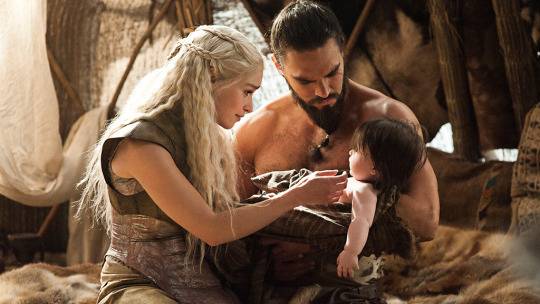
Here, she was reunited with her true love and husband, Khal Drogo and their son, Rhaego.
Perhaps this was a foreshadowing of sorts, that she will die in battle beyond the wall during the Long Night, and in death, be reunited with her son and husband -who wait for her in some form of purgatory, so they can all ride together into the Night Lands?
Drawing from the Henry Dany/Jon parallels, and if you’d like to get real tinfoil-y, we could look at Targcest as a way of melding these two halves of Henry into one. Maybe Dany perishes before the showdown with Cersei -leaving that war for Jon to be the parallel to Henry’s Battle of Bosworth -the battle that won him the crown by conquest -as to which he strengthened by then marrying Elizabeth of York.
*I’d like to make that very clear. He didn’t use his new wife to seal the deal, he used conquest (in defeating his rival) -he strengthened his throne (and future line of succession) in marrying EoY.
Returning back to Dany’s visions in The House of the Undying, she enters the throne room and it looks destroyed -although the throne still remains intact. Some people think it was ash falling through the broken ceiling -others snow. I’m going with the latter. Here’s why:
Dany approaches the throne, but does not touch it -instead she walks out the door which led her to the other side of the wall (to her family). She’s come to Westeros, but she will never be the queen. Instead, Jon will be the reluctant King -again thrust into a position of leadership that he doesn’t necessarily want, but will accept for the good of all. He will not be a King who conquered, but instead a King that was chosen.
Since Jon is both a Stark and a Targaryen, but his Targaryen lineage is what gives him a right to the Iron Throne -ironically, a Targaryen will once again rule Westeros. With Dany’s death, so dies the old House Targaryen that she represents, with Jon being the start of a new (and as @thewesterwoman points out -less incestuous) dynasty. This would again mirror the fate of House Plantagenet.
But will he rule as a Targaryen? Or a Stark? Maybe neither?
Perhaps he will rule as a Snow -which considering the connotations, and how being a bastard plagued him his entire life, it would certainly be rather poetic. The Snow falling in the throne room could be a foreshadowing of this. The Targaryen structure is destroyed, but the throne that Targaryen and Lannisters have sat on, is intact.
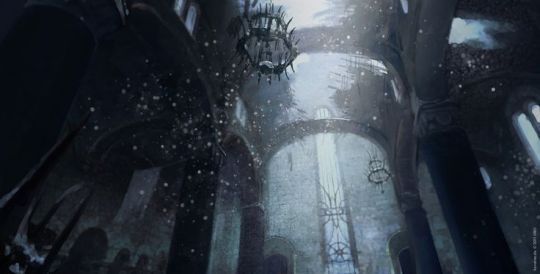
And remember this? The blending of the Lancaster and York roses into the Tudor rose?
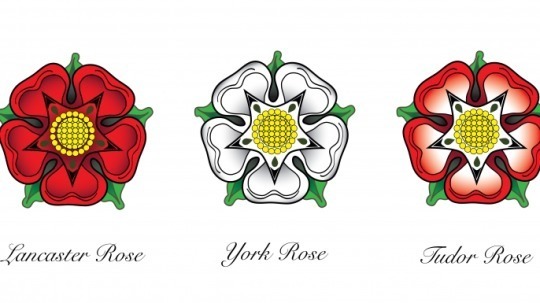
This also leads me to believe that Jon might start a new house entirely, and create his own house sigil -combining the Targaryen and Starks somehow, but allowing BOTH original houses to die off -much like both the Lancasters and Yorks, with no male heirs left to carry on the names. In the books, snow is a big theme in a lot of Sansa’s arc -especially the time she spends as Alayne in the Vale. Many have already drawn these parallels to Jon.
There Must Always be a Stark in Winterfell
(Inspired by the ask I sent thewesterwoman)

Bran has made it pretty clear that he is NOT the Lord of Winterfell. Bran technically isn’t even Bran anymore. *Think of Elizabeth of Yorks two brothers (the princes in the tower). If Arya marries, she will take her husband’s name -same with Sansa. So, if Jon doesn’t take the Stark name, the Stark name perishes, too.
Consider if you will, that Winterfell falls in the Long Night. It was built by Brandon Stark (aka: Bran the builder), one of the “First Men”, as well as the founder of House Stark. He also is said to have built the Wall -“raised it with the aid of Giants”, according to legend. Ironically, the Night King is known to be one of the First Men, too. Supposedly, Bran Stark is in the Winterfell crypts, although some have speculated that he’s actually the NK.
What if there’s something “magical” behind Winterfell and it’s crypts? When Bran asked undead Benjen to come with them to the other side of the wall, he said he couldn’t, as there was magic carved into the foundation of the Wall, and as long as it stood, he could not pass. Maybe there’s something magical connected to Winterfell and the phrase “there must always be a Stark in Winterfell” and, that it’s all somehow connected to the Night King.
If the Night King is defeated once and for all, and Winterfell falls, there’s no longer a “need” for a Stark to be there -giving credence to the theory of Jon starting a new house entirely.
With the Starks being the “good guys” and the story mostly framed around them, Jon and Sansa as Ned/Cat 2.0 yet, the end of House Stark sounds pretty bittersweet to me.
Of course, this is all just speculation …
War of the Roses was only one of many things that GRRM drew inspiration from.
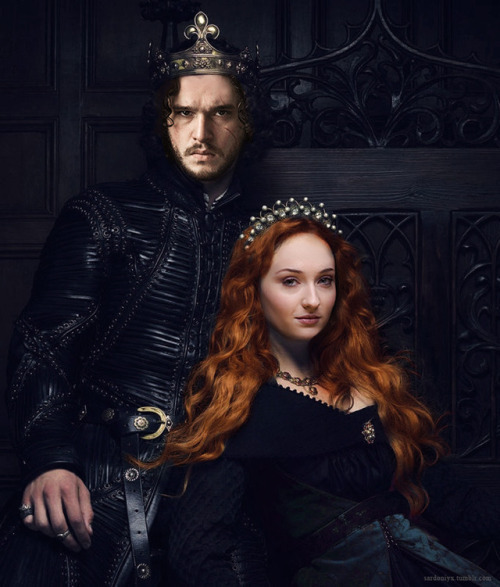
*credit to @sardoniyx for this AMAZING manip work!*
#got meta#wars of the roses#jonsa meta#got predictions#got speculation#jonsa is endgame#wars of the roses parallels#asoiaf#asoiaf meta#jonsa#jon x sansa
1K notes
·
View notes
Text
Import and Export Price Indexes

Transmission of material in this release is embargoed until USDL-18-1455 8:30 a.m. (EDT) Friday, September 14, 2018 Technical information: (202) 691-7101 * [email protected] * www.bls.gov/mxp Media contact: (202) 691-5902 * [email protected] U.S. IMPORT AND EXPORT PRICE INDEXES - AUGUST 2018 U.S. import prices declined 0.6 percent in August, the U.S. Bureau of Labor Statistics reported today, following a 0.1-percent decrease the previous month. Falling prices for both fuel and nonfuel imports contributed to the August decline. Prices for U.S. exports edged down 0.1 percent, after decreasing 0.5 percent in July. Imports Import prices declined 0.6 percent in August, the largest monthly drop since the index fell 1.3 percent in January 2016. The August decrease followed a 0.1-percent decline in July and was only the third monthly drop over the past 12 months. Prices for U.S. imports advanced 3.7 percent from August 2017 to August 2018 and have not recorded a 12-month decline since October 2016. (See table 1.) New Locality of Destination and Terms of Trade Data Available New Locality of Destination export price indexes are available in table 8 and new Terms of Trade indexes by locality are available in table 9. For more information on the new index series, please see page 5. Fuel Imports: Import fuel prices decreased 3.9 percent in August, the first decline for the index since a 2.6- percent drop in March and the largest monthly decline since a 6.8-percent decrease in February 2016. Petroleum prices declined 3.9 percent in August, after increasing in each of the previous 4 months, and natural gas prices fell 6.3 percent following an 18.0-percent increase in July. Despite the downturn in August, fuel prices rose 30.6 percent over the past 12 months. The price index for petroleum increased 33.0 percent for the year ended in August, and prices for natural gas decreased 11.7 percent over the same period. All Imports Excluding Fuel: Nonfuel import prices edged down 0.1 percent in August, after decreasing 0.3 percent in each of the previous 2 months. In August, the decline was driven by falling prices for nonfuel industrial supplies and materials, although lower capital goods prices also contributed. In contrast, the price index for foods, feeds, and beverages advanced in August. Despite the downward trend over the past 3 months, nonfuel import prices increased 0.9 percent between August 2017 and August 2018. The increase was led by a 6.4-percent rise in nonfuel industrial supplies and materials prices over the 12-month period. Nonfuel Industrial Supplies and Materials: The price index for nonfuel industrial supplies and materials fell 0.8 percent in August following a 1.1-percent decline the previous month. The August decrease was led by a 1.9-percent drop in unfinished metals prices and a 2.6-percent decline in building materials prices. Finished Goods: Import prices for finished goods categories were mostly unchanged in August. The price index for capital goods edged down 0.1 percent, after recording no change in July. Prices for consumer goods and automotive vehicles recorded no change in August. Foods, Feeds, and Beverages: Foods, feeds, and beverages prices advanced 0.4 percent in August following a 1.6-percent decline the previous month. Table A. Percent change in Import and Export Price Indexes, selected categories
Month IMPORTS EXPORTS All
imports Fuel
imports Nonfuel
imports All
exports Agri-
cultural
exports Non-
agricultural
exports
2017
August
0.6 4.0 0.3 0.6 0.0 0.7
September
0.8 5.7 0.3 0.8 -0.7 0.9
October
0.2 0.3 0.1 0.1 2.0 -0.1
November
1.0 9.8 0.0 0.5 -0.7 0.7
December
0.2 3.3 -0.2 0.1 -0.3 0.0
2018
January
0.8 3.3 0.5 0.7 0.0 0.8
February
0.2 -1.8 0.4 0.2 0.6 0.2
March
-0.2 -2.6 0.1 0.4 3.2 0.1
April
0.5 4.0 0.1 0.5 -1.1 0.7
May
0.9 (r)6.1 0.2 0.7 1.6 0.6
June
(r)0.1 (r)2.6 -0.3 0.2 -1.0 0.4
July
(r)-0.1 (r)1.0 -0.3 -0.5 (r)-5.2 0.0
August
-0.6 -3.9 -0.1 -0.1 0.2 -0.2
Aug. 2016 to 2017
2.0 14.4 1.0 2.3 1.7 2.4
Aug. 2017 to 2018
3.7 30.6 0.9 3.6 -1.7 4.1
Footnotes
(r) Revised
Exports Prices for U.S. exports decreased 0.1 percent in August, after declining 0.5 percent in July. The July downturn was the first monthly drop since June 2017. In August, lower prices for nonagricultural exports more than offset higher agricultural prices. The price index for overall exports advanced 3.6 percent for the year ended in August and has not recorded a 12-month decline since a 0.2-percent decrease in November 2016. (See table 2.) Agricultural Exports: The price index for agricultural exports rose 0.2 percent in August following a 5.2- percent decline the previous month. In August, higher prices for soybeans, wheat, and corn more than offset lower prices for meat, nuts, and fruit. Agricultural prices decreased 1.7 percent for the year ended in August, after increasing 1.7 percent between August 2016 and August 2017. Falling prices for soybeans, fruit, and meat all contributed to the decline over the past 12 months. All Exports Excluding Agriculture: Nonagricultural export prices fell 0.2 percent in August, after recording no change in July. The August decrease was led by declining prices for nonagricultural industrial supplies and materials, consumer goods, and automotive vehicles. In contrast, the price index for capital goods advanced in August. Prices for nonagricultural exports increased 4.1 percent over the past year and have not recorded a 12-month decline since November 2016. Nonagricultural Industrial Supplies and Materials: Prices for nonagricultural industrial supplies and materials decreased 0.6 percent in August following a 0.2-percent decline the previous month. The declines in August and July were both driven by lower metals prices. Despite the recent downturn, the index advanced 9.7 percent for the year ended in August. Finished Goods: Finished goods prices were mixed in August. The price indexes for consumer goods and automotive vehicles each fell 0.1 percent. In contrast, capital goods prices advanced 0.2 percent in August, after ticking up 0.1 percent in July. The August increase was led by higher prices for electrical generating equipment. Measures of Import and Export Prices by Locality Imports by Locality of Origin: The price index for imports from China edged down 0.1 percent for the second consecutive month in August. Those were the first monthly declines for the index since a 0.3-percent drop in September 2017. Prices for imports from Japan recorded no change in August following a 0.2- percent increase in July and a 0.1-percent decrease in June. Import prices from Japan rose 1.0 percent over the past year, the largest 12-month advance since the index increased 1.0 percent between June 2016 and June 2017. The price index for imports from Canada fell 1.5 percent in August, after recording no change the previous month. The August decline was led by lower petroleum prices. Prices for imports from the European Union and Mexico each decreased 0.1 percent in August. (See table 7.) Exports by Locality of Destination: Prices for exports to China edged down 0.1 percent in August following declines of 2.1 percent in July and 0.6 percent in June. Export prices to Japan declined for the third consecutive month in August, falling 0.4 percent, after decreasing 1.2 percent in July and 0.3 percent in June. The price index for exports to the European Union fell 0.2 percent in August following 0.1-percent drops in each of the previous 2 months. In August, the decline was led by a 0.2-percent decrease in manufactured goods prices. In contrast, prices for exports to Canada and Mexico each ticked up 0.1 percent in August. (See table 8.) Terms of Trade Indexes: Terms of Trade indexes are based on the country, region, or grouping and measure the change in the purchasing power of exports relative to imports. The U.S. terms of trade index with China recorded no change in August following a 2.0-percent decline in July and a 0.6-percent drop in June. Both the July and June decreases were driven by falling export prices to China. The U.S. terms of trade index with Japan decreased 0.4 percent in August, after declining 1.3 percent the previous month. The index for U.S. terms of trade with the European Union decreased 0.2 percent in August, after edging down 0.1 percent in July. In August, the U.S. terms of trade index with Canada advanced 1.6 percent and with Mexico rose 0.2 percent. (See table 9.) Import and Export Services Imports: Import air passenger fares declined 8.8 percent in August, the largest decrease since a 10.6- percent drop in August 2017. Falling European, Asian, and Latin American/Caribbean fares all contributed to the drop in August 2018. Despite the August decline, import air passenger fares advanced 3.5 percent over the past year. Prices for import air freight decreased 0.6 percent in August and increased 3.0 percent over the past 12 months. (See table 10.) Exports: The index for export air passenger fares fell 3.7 percent in August, after increasing 1.6 percent in July and 5.0 percent in June. The August downturn was driven by an 11.1-percent drop in European fares. Export air passenger fares fell 3.3 percent over the past 12 months, the largest over-the-year decline since a 5.8-percent drop in December 2017. Export air freight prices decreased 0.6 percent in August and rose 3.4 percent over the past year. Import and Export Price Index data for September are scheduled for release on Friday, October 12, 2018 at 8:30 a.m. (EDT). New Locality of Destination and Terms of Trade Data Beginning with the August news release on September 14, the BLS introduced two new data series. Locality of Destination price indexes measure export prices based on the country, region, or grouping where items are exported. Terms of Trade indexes are based on the country, region, or grouping and measure the relative price for exports in terms of import prices and are defined as the all-export price index divided by the corresponding all-import price index. For more information on Terms of Trade indexes, please see "U.S. Import and Export Prices and the Terms of Trade" at www.bls.gov/opub/btn/archive/us-import-and-export- price-indexes-and-the-terms-of-trade.pdf. The Locality of Destination price indexes are published at the all-export level and also include a breakdown by manufacturing industries and nonmanufacturing industries where possible. The countries, regions, or groupings for which indexes are published include the Industrialized Countries, the European Union, Latin America, the Pacific Rim, Canada, China, Germany, Japan, and Mexico. Indexes by manufacturing industries and nonmanufacturing industries are available for all countries and regions except Canada and Germany. Terms of Trade indexes are available for all countries, regions, and groupings where both the import Locality of Origin price index and the export Locality of Destination price index are published. These include the Industrialized Countries, the European Union, Latin America, the Pacific Rim, Canada, China, Germany, Japan, and Mexico. The first publication month for the data series for both Locality of Destination price indexes and the Terms of Trade indexes is December 2017. In addition to the new indexes, the numbering of the tables in the Import and Export Price Index news release changed. Tables 1 through 7 remain the same, and the new Locality of Destination data are in table 8 and the new Terms of Trade data are in table 9. The previous table for Selected Transportation Services changed from table 8 to table 10.
0 notes
Text
Relist Watch
John Elwood reviews Monday’s relists.
I’ve got to be extremely summary this week because of the press of urgent work. First, we’ll dispatch the old business: Last week’s relists yielded five new grants (with the justices picking Comcast Corporation v. National Association of African American-Owned Media, 18-1171, over its companion Charter Communications Inc. v. National Association of African American-Owned Media, 18-1185, to resolve an issue about the showing of causation required for a claim of discrimination in cable-carriage decisions). And we got a statement respecting denial from Justice Stephen Breyer in four-time relist al-Alwi v. Trump, 18-740, concerning the indefinite detention of enemy combatants at Guantanamo.
That brings us to this week’s new business. There are no cases that have been relisted for the first time this week. But there’s a trio of closely watched cases that have been relisted for a second time … sort of. The federal government has three pending petitions involving the Trump administration’s decision to end the Deferred Action for Childhood Arrivals policy: Department of Homeland Security v. Regents of the University of California, 18-587, Trump v. NAACP, 18-588, and McAleenan v. Vidal, 18-589. The court relisted all three after the January 11 conference, and there they sat for five months. Court-watchers have speculated about what was going on; to me, it looked like the court was holding the cases for something on its merits docket, perhaps the census case, perhaps Azar v. Allina Health Services – both administrative law cases addressing steps the government must take to justify certain actions. Neither is clearly related to DACA, but the court has a pretty low threshold for holding a case if it might be affected. Because these cases have been set for conference after a long period of stasis, I would normally classify them as “released holds” rather than relists.
Recently, the court rejected the government’s request to expedite consideration of a fourth DACA petition, in which the government argued that there was an “urgent need for the[] prompt consideration” of the DACA petitions “before the Court’s summer recess.” By releasing the apparent hold on the first three DACA petitions and setting them for consideration this Thursday, the court has set the stage for the government to get what it sought in its motion – a decision before the summer recess on whether the court will hear the DACA cases, and, if cert is granted, briefing over the summer in preparation for a fall argument.
That’s all for this week. Thanks again to Ben Moss for compiling the relists.
New Relists
See above.
Returning Relists
Roman Catholic Archdiocese of San Juan, Puerto Rico v. Feliciano, 18-921
Issue: Whether the First Amendment empowers courts to override the chosen legal structure of a religious organization and declare all of its constituent parts a single legal entity subject to joint and several liability.
(relisted after the March 22, March 29, April 12, April 18, April 26, May 9, May 16, May 23, May 30 and June 6 conferences)
Department of Homeland Security v. Regents of the University of California, 18-587
Issues: (1) Whether the Department of Homeland Security’s decision to wind down the Deferred Action for Childhood Arrivals policy is judicially reviewable; and (2) whether DHS’ decision to wind down the DACA policy is lawful.
(relisted after the January 11 and January 18 conferences)
Trump v. NAACP, 18-588
Issues: (1) Whether the Department of Homeland Security’s decision to wind down the Deferred Action for Childhood Arrivals policy is judicially reviewable; and (2) whether DHS’ decision to wind down the DACA policy is lawful.
(relisted after the January 11 and January 18 conferences)
McAleenan v. Vidal, 18-589
Issues: (1) Whether the Department of Homeland Security’s decision to wind down the Deferred Action for Childhood Arrivals policy is judicially reviewable; and (2) whether DHS’ decision to wind down the DACA policy is lawful.
(relisted after the January 11 and January 18 conferences)
Klein v. Oregon Bureau of Labor and Industries, 18-547
Issues: (1) Whether Oregon violated the free speech and free exercise clauses of the First Amendment by compelling the Kleins to design and create a custom wedding cake to celebrate a same-sex wedding ritual in violation of their sincerely held religious beliefs; (2) whether the Supreme Court should overrule Employment Division, Department of Human Resources of Oregon v. Smith; and (3) whether the Supreme Court should reaffirm Smith’s hybrid-rights doctrine, applying strict scrutiny to free exercise claims that implicate other fundamental rights, and resolve the circuit split over the doctrine’s precedential status.
(relisted after the March 29, April 12, April 18, April 26, May 9, May 16, May 23, May 30 and June 6 conferences)
McGee v. McFadden, 18-7277
Issues: (1) Whether the U.S. Court of Appeals for the 4th Circuit erred when it found no constitutional error when the state failed to disclose Brady evidence, a letter from a jailhouse snitch, until the post-trial hearing for a motion for a new trial; (2) whether the state and federal courts’ decisions were contrary to Giglio v. United States, United States v. Bagley, Brady v. Maryland and Napue v. Illinois when the state failed to disclose material impeachment evidence, a letter from a jailhouse snitch who testified that petitioner confessed to him; and (3) whether the state and federal courts erred in finding that trial counsel rendered effective assistance of counsel when he failed to interview Michael Jones and call him as a witness.
(relisted after the April 12, April 18, April 26, May 9, May 16, May 23, May 30 and June 6 conferences)
Box v. Planned Parenthood of Indiana and Kentucky, 18-1019
Issue: Whether a state, consistent with the 14th Amendment, may require an ultrasound as part of informed consent at least 18 hours before an abortion.
(relisted after the May 9 and May 16 conferences; now held)
Jordan v. City of Darien, Georgia, 17-1455
Issue: Whether the existence of probable cause defeats a First Amendment retaliatory arrest claim as a matter of law.
(relisted after the May 30 and June 6 conferences)
The post Relist Watch appeared first on SCOTUSblog.
from Law https://www.scotusblog.com/2019/06/relist-watch-147/
via http://www.rssmix.com/
0 notes
Photo
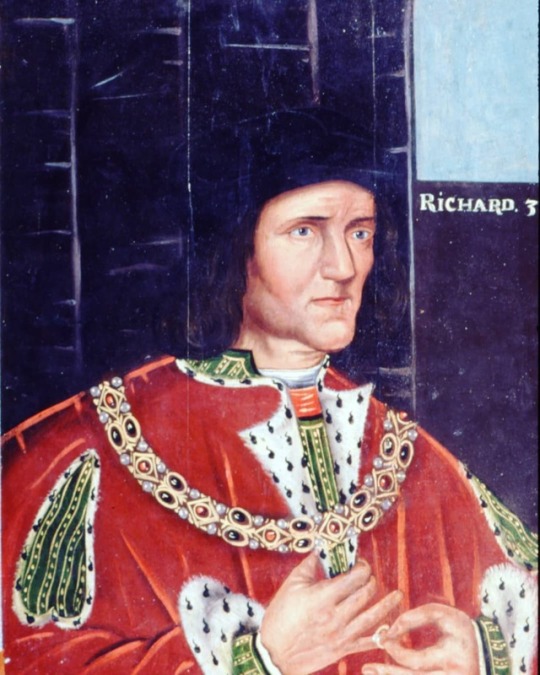
Richard III was born on this day in history 2 October 1452 . . He was one of twelve children, although most died young . . ◼ Anne of York (10 August 1439 – 14 January 1476) . ◼ Henry of York (10 February 1441, Hatfield – died young) . ◼ Edward IV of England (28 April 1442 – 9 April 1483). Married to Elizabeth Woodville . ◼ Edmund, Earl of Rutland (17 May 1443 – 30 December 1460) . ◼ Elizabeth of York (22 April 1444 – after January 1503). Not to be confused with Edward IV's daughter . ◼ Margaret of York (3 May 1446 – 23 November 1503). Married to Charles the Bold, Duke of Burgundy . ◼ William of York (b. 7 July 1447, died young) . ◼ John of York (b. 7 November 1448, died young) . ◼ George, Duke of Clarence (21 October 1449 – 18 February 1478) . ◼ Thomas of York (born c. 1451, died young) . ◼ Richard III of England (born this day in history 2 October 1452 – 22 August 1485) . ◼ Ursula of York (born 22 July 1455, died young). . . . #Onthisdayinhistory #thisdayinhistory #theyear1452 #d2oct #RichardIII #RichardIIIofEngland #KingRichardIII #HouseofYork #Historyfacts #Heritage #royalty #KingofEngland #EnglishHistory #EnglishMonarchy #Britishmonarchy #Thebritishmonarchy (at England) https://www.instagram.com/p/BocgmfolU1V/?utm_source=ig_tumblr_share&igshid=9i3blubq2tyz
#onthisdayinhistory#thisdayinhistory#theyear1452#d2oct#richardiii#richardiiiofengland#kingrichardiii#houseofyork#historyfacts#heritage#royalty#kingofengland#englishhistory#englishmonarchy#britishmonarchy#thebritishmonarchy
0 notes
Photo
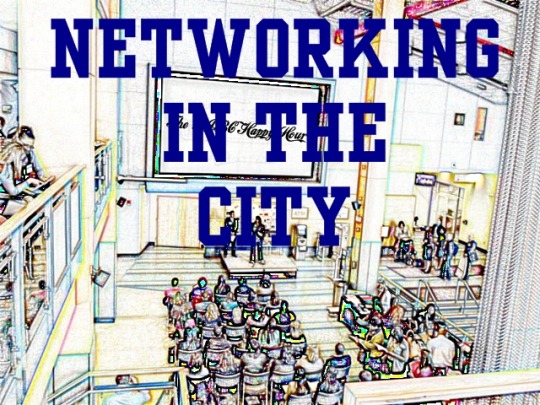
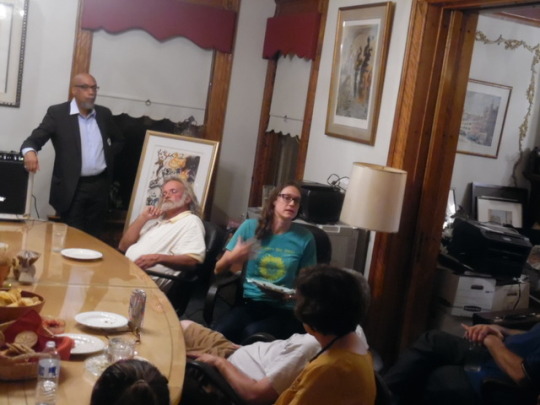
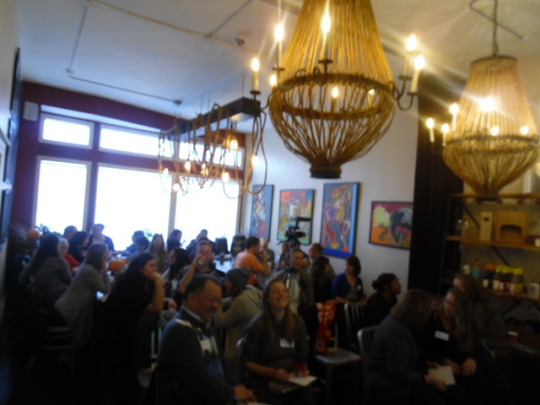
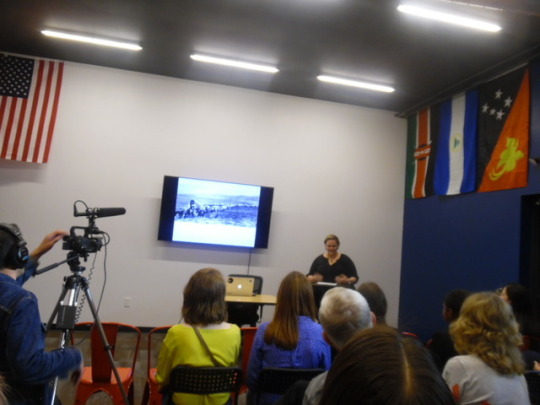

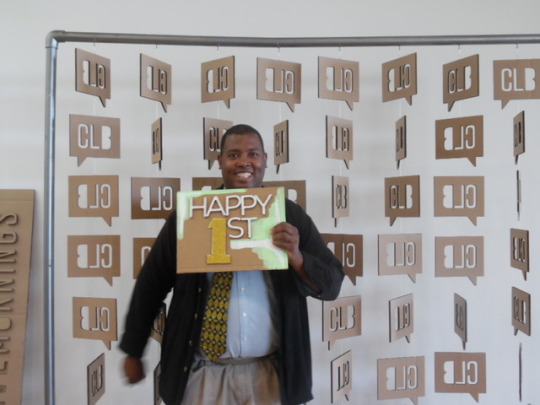
January & February 2018 Networking Calendar
It’s a New Year. How about a New You? Will 2018 be the year that you make the new sale? Will it be the year you grow your business? Will it be the year you get that NEW job? Networking is the answer to everything that matters in the road of business. Here are some area events in January and February.
JANUARY
January 5
- First Fridays with Influential Females – Amy Schmittauer (This Event has Already PASSED)
January 11
- Lessons in Leadership: Networking in the New Year (7-9AM; Alumni Auditorium at Franklin University: 301 E. Rich St., Discovery District; http://www.cypclub.com) (BUS - # 2 East Main/North High, # 7 Mount Vernon, # 11 Bryden/Maize, or the CMAX)
- Tri-Village Luncheon (11:30AM-1PM; Zauber Endeavor Brewing: 909 W. 5th Ave., 5th by Northwest; http://chamberpartnership.org) (Bus - # 5 West 5th/Refugee or # 22 Ohio/Rickenbacker)
- GETDOT Networking (5-7PM; Club 145: 955 W. 5th Ave., 5th by Northwest; http://www.getdotnetworking.org) (Bus - # 5 or 22)
- Healthy New Year, Worthington! Worthington Health and Wellness Expo (Noon-6PM; Shops at Worthington Place: 7227 N. High St., Worthington; http://www.worthingtonchamber.org) (Bus - # 2L - N. High/Polaris)
January 13
- Livingston Avenue Area Commission Annual Meting (10AM; Ann Isaly Wolfe Education Center at Nationwide Children’s Hospital; 700 Children’s Drive [575 S. 18th St.], South Side; http://www.facebook.com/LivAveAC) (Bus - # 1 Kenny/Livingston)
- Free Press Second Saturday Salon (6:30-11PM; Columbus Free Press: 1021 E. Broad St., Olde Towne East; http://www.columbusfreepress.com) (Bus - # 10 East/West Broad)
January 14
- A Local Table with Jim Coe (1-3PM; Bexley Coffee Shop: 492 N. Cassady Ave., Bexley; http://orangeacorn.wordpress.com)
January 17
- Gahanna 2017 In Review (11:30AM-1:30PM; Creekside Conference & Events Center: 101 Mill St., Suite 300; http://www.gahannaareachamber.com) (Bus - # 25 Brice)
- Bexley Networking Luncheon (12:30-1:30PM; Rusty Bucket Bexley: 2152 E. Main St., Bexley; http://www.bexleyareachamber.org) (Bus - # 2)
January 18
- CYP Coffee Talk (7:30-9AM; Chocolate Café: 1855 Northwest Blvd., 5th by Northwest; http://www.cypclub.com) (Bus - # 3 Northwest/Harrisburg)
January 19
- Creative Mornings Columbus: Anxiety (8:30-10AM; Greater Columbus Convention Center: 400 North High Street, Short North; http://creativemornings.com/cities/clb) (Bus - # 1, # 2, # 5, or the CBUS)
- Hilliard Chamber Luncheon – “Crisis Communication in a 24/7 World” (11:30AM-1PM; Heritage Golf Club: 3525 Heritage Club Drive; Hilliard; http://www.hilliardchamber.org)
- AAF Columbus Podcasting Panel (11:30AM-1PM; The Bluestone: 583 E. Broad St., Discovery District; http://www.aafcolumbus.org) (Bus - # 10)
January 22
- Upper Arlington State of the City Address (5:30-8PM; Upper Arlington Municipal Services Building: 3600 Tremont Rd., Upper Arlington; http://chamberpartnership.org and http://www.uaoh.net) (Bus - # 1 Kenny/Livingston)
- Columbus Urban League Young Professionals Join Week: Negotiating Anything LIVE Podcast; 5:30-8PM; Two Dollar Radio Headquarters: 1124 Parsons Ave., South Side; http://www.culyp.org) (Bus - # 4 Indianola/Lockbourne or # 8 Karl/PARSONS)
January 23
- YP Networking Night (5:30-7:30PM; Serendipity Labs: 21 E. State St., Suite 200, Downtown; http://www.cypclub.com) (Bus - # 1, 2, 2L, CBUS, or CMAX)
- AMA Job Transition Strategies (6:30-8PM; Improving Enterprises: 1 Easton Oval, Suite 175, Easton; http://www.columbusama.org) (Bus - # 7 Mount Vernon, # 23 James-Stelzer, or # 32 North Broadway)
January 26
- Breakfast with Business First (7-9AM; Verizon Wireless: 5100 Britton Parkway, Hilliard; http://www.columbusbusinessfirst.com) (Bus - # 21 Hilliard-Rome)
January 27
- Hilliard Health & Wellness Fair (10AM-3PM; Hilliard Darby High School: 4200 Leppert Rd., Hilliard; http://www.hilliardchamber.org)
January 30
- Personal Branding: Learn How To Impress Employers (5-7PM; Alumni Hall at Franklin University: 301 E. Rich St., Downtown Columbus; http://www.cypclub.com) (Bus - # 2, 7, 11, or CMAX)
January 31
- City of Columbus State of Our City Community Conversations; Part 1: Neighborhoods and Public Safety (6PM; Reeb Avenue Center: 280 Reeb Ave., South Side; http://www.columbus.gov) (Bus - # 8 Karl/Parsons)
FEBRUARY
February 1
- AMA Firsty Thursdays (5:30-7:30PM; The Eagle: 790 N. High St., Short North; http://www.columbusama.org) (Bus - # 1, 2, 5, or CBUS)
February 2
- Worthington Groundhog Day Business Forecast (7-9:15AM; Brookside Golf and Country Club: 2770 W. Dublin-Granville Rd., Worthington; http://www.worthingtonchamber.org)
- First Friday with Influential Females (7:30-9AM; Serendipity Labs: 21 E. State St., Suite 200, Downtown Columbus; http://www.cypclub.com) (Bus - # 1, 2, CBUS, or CMAX)
- Gahanna Groundhog Day Economic Forecast Breakfast (7:30-9AM; Creekside Conference and Event Center: 101 Mill St., Suite 300, Gahanna; http://www.gahanna.gov) (Bus - # 25)
February 8
- Lessons In Leadership (7-9AM; Alumni Auditorium at Franklin University: 301 E. Rich St., Discovery District; http://www.cypclub.com) (Bus - # 2, 7, 11, or CMAX)
-Tri-Village Luncheon (11:30AM-1PM; Grandview Café: 1455 W. 3rd Ave., 5th by Northwest; http://chamberpartnership.org) (Bus - # 31 Hudson)
- GETDOT Networking (5-7PM; Barley’s Brewing: 467 N. High St., Short North; http://www.getdotnetworking.org) (Bus - # 1, 2, 5, or CBUS)
February 10
- Free Press Second Saturday Salon (6:30-11PM; Columbus Free Press: 1021 E. Broad St., Olde Towne East; http://www.columbusfreepress.com) (Bus - # 10)
February 13
- City of Columbus State of Our City Community Conversations; Part 2: CelebrateOne, Public Health, and Opioid Addition (6PM; J. Ashburn Boys and Girls Club Youth Center: 85 Clarendon Ave., The Hilltop; http://www.columbus.gov) (Bus - # 10)
February 15
- CYP Coffee Talk (7:30-9AM; Chocolate Café: 1855 Northwest Blvd., 5th by Northwest; http://www.cypclub.com) (Bus - # 3)
February 16
- Creative Mornings Columbus: Curiousity (8:30-10AM; Amelita Mirolo Barn at Sunny 95 Park: 4395 Carriage Hill Lane, Upper Arlington; http://creativemornings.com/cities/clb)
February 20
- CYP Club Networking Night (5:30-7:30PM; Royal Rhino Club Barbershop and Lounge: 993 N. 4th St., Italian Village; http://www.cypclub.com) (Bus - # 4 Indianola/Lockbourne or 12 McKinley/Fields)
February 21
- Bexley Networking Luncheon (12:30-1:30PM; Bexley Public Library - Auditorium: 2411 E. Main St., Bexley; http://www.bexleyareachamber.org) (Bus - # 2)
- City of Columbus State of Our City Community Conversations; Part 3: Recreation and Parks and Pre-K Education (6PM; Linden Recreation Center: 1254 Briarwood Ave., Linden; http://www.columbus.gov) (Bus - # 8 or 11)
February 22
- Bexley Area Chamber Business After Hours (5:30-7PM; Camelot Cellars: 901 Oak St., Olde Towne East; http://www.bexleyareachamber.org) (Bus - # 10 or 11)
- City of Columbus State of Our City Community Conversations; Part 4: Diversity and Inclusion and Columbus Women’s Commission (6PM; King Arts Complex: 867 Mount Vernon Ave., King-Lincoln District; http://www.columbus.gov) (Bus - # 7)
February 23
- Breakfast with Business First (7-9AM; Navigator Management Partners: 1400 Goodale Boulevard, Grandview Heights; http://www.columbusbusinessfirst.com)
February 26
- Multi-Chamber Business Expo (Dublin/Hilliard/Westerville/Powell/Union County) (4:30-7PM; The Exchange at Bridge Park: 652 Riverside Drive, Dublin; http://www.dublinchamber.org) (Bus - # 33 Henderson)
- Bexley State of the Community Address (5:30-8PM; Capital University Convergent Media Center: 590 College Ave., Bexley; http://www.bexley.org) (Bus - # 2)
February 27
- AMA Job Transition Strategies (6:30-8PM; Improving Enterprises: 1 Easton Oval, Suite 175, Easton; http://www.columbusama.org) (Bus - # 7, 23, or 32)
February 28
- Bexley Business Breakfast with Capital University President Dr. Beth Paul (8-9:15AM; Market District Kitchen & Bar: 2250 E. Main St., Bexley; http://www.bexleyareachamber.org) (Bus - # 2)
Looking Ahead to March...
March 1
- AMA Firsty Thursdays
March 2
- CYP Club First Friday Females
March 8
- CYP Club/Franklin Leadership Panel: Job Search Tips & Trends
0 notes
Text
King João and Queen Philippa 2nd Child: Pedro, Duke of Coimbra

Infante D. Pedro, Duke of Coimbra (9 December 1392 – 20 May 1449) was a Portuguese infante (prince) of the House of Aviz, son of King João I of Portugal and his wife Philippa of Lancaster, daughter of John of Gaunt. In Portugal, he is better known as Infante D. Pedro das Sete Partidas [do Mundo], "of the Seven Parts [of the World]" because of his travels. Possibly the best-travelled prince of his time, he was regent between 1439 and 1448. He was also 1st Lord of Montemor-o-Velho, Aveiro, Tentúgal, Cernache, Pereira, Condeixa and Lousã.
Early life
From the time he was born, Pedro was one of João I's favourite sons. Along with his siblings, he received an exceptional education rarely seen in those times for the children of royalty. Close to his brothers Duarte the future king of Portugal, and João, Lord of Reguengos de Monsaraz, Pedro grew up in a calm environment free of intrigues.
On 14 August 1415, he accompanied his father and brothers Duarte and Henrique for the Battle of Ceuta in Morocco. His mother had died the previous month, giving each of her sons on her deathbed an arming sword she had ordered forged for them. Pedro refused to be knighted before showing valor in battle, and he was knighted along with his brothers the following day; he was also created Duke of Coimbra. His younger brother Henrique was made Duke of Viseu. These were the first dukedoms created in Portugal.
On finishing a translation of Seneca's De Beneficiis in 1418, he initiated extensive travels throughout Europe, which would keep him away from Portugal for the next ten years. After meeting with Juan II of Castile in Valladolid, he continued to Hungary, where he met with the Holy Roman Emperor Sigismund, and entered his service. He fought with the Imperial armies against the Turks and in the Hussite Wars in Bohemia and was awarded the march of Treviso in Northern Italy in 1422. In 1424 he left the Holy Roman Empire, meeting first with Murad II, Sultan of the Ottoman Empire, on the island of Patmos, and then continuing to Constantinople, capital of the Byzantine Empire; the hopeless position of the city against the Ottoman onslaught did not fail to impress him. From Constantinople he traveled to the Holy Land via Alexandria and Cairo.
European travels
In 1425, Peter travelled to France and England and visited the universities of Paris and Oxford before arriving in Flanders in 1426, where he spent the next two years at the Burgundian court. After the death of the second wife of Philip the Good of Burgundy in 1425, Pedro recommended his sister Isabel to him as a wife. Philip sent a delegation to Portugal in 1428–29 that included Jan van Eyck, who painted two portraits of the Infanta. Philip and Isabel eventually married on 7 January 1430, and one of their sons became Duke Charles the Bold of Burgundy.
In 1427, Pedro wrote a famous letter to his older brother, later King Duarte, on "the proper administration of the kingdoms", from Bruges. Later that year, King Henry VI of England (his first cousin once removed) made him a Knight of the Garter (as were already his father and older brother Duarte).
In 1428, Pedro visited his marquisate of Treviso and the nearby Republic of Venice, where he was presented with a copy of the book of Marco Polo by the doge. He later gave that book, as well as maps of the Venetian trade routes in the Orient, to his younger brother Prince Henrique the Navigator. One of the maps was created by the famous Venetian cartographer Albertinus de Virga in 1411 and possibly shows North America before it was officially discovered. This map was found in the Alcobaça Monastery which was the main library of the Portuguese Royal family. From Venice he traveled to Rome, where he was received by Pope Martin V, and from there he continued to Barcelona, where he negotiated the marriage of his brother Duarte with Leonot of Aragon as well as his own future marriage with Isabella of Urgell, before finally returning to Portugal.
In 1433, he completed his famous six-volume work, the Tratado da Virtuosa Benfeitoria.

Regent
When Pedro’s brother King Duarte of Portugal died in 1438, Pedro's nephew Afonso V ascended the throne as an infant. At first, the choice for regent was the Queen mother Leonor of Aragon. This choice was not popular among many Portuguese, because Leonor was Aragonese. In a meeting of the Portuguese Cortes summoned by Peter's brother João, Lord of Reguengos de Monsaraz, Pedro was appointed regent of the kingdom during the minority of his nephew Afonso V, a choice that pleased both the people and the fast-growing bourgeoisie.
Inside the Portuguese aristocracy, however, especially among nobles around Pedro's half-brother Afonso, Count of Barcelos, Leonor of Aragon was preferred, and there were doubts about Pedro's political ability. A "war of influences" started, and a few years later, Afonso of Barcelos managed to become young King Afonso V's favourite uncle.
In 1443, in a gesture of reconciliation, Pedro created his half-brother Afonso Duke of Braganza, and relations between the two seemed to return to normality. But, in 1445, the new duke of Braganza took offence because Isabel of Coimbra, Pedro's daughter was the choice for Afonso V's wife, and not one of his granddaughters. Indifferent to the intrigues, Pedro continued his regency and the country prospered under his influence. It is during this period that the first subsidies for the exploration of the Atlantic Ocean were implemented under the auspices of Pedro's brother Henrique the Navigator.

Alleged Rebellion
On 9 June 1448, Afonso V came of age and Pedro returned control of the country to the king. Influenced by Afonso, the Duke of Braganza, Afonso V nullified all of Pedro's edicts, including the ones that concentrated power in the figure of the king.
The following year, under accusations that years later would prove false, Afonso V declared Pedro a rebel. The situation became unsustainable and a civil war began. It did not last long, because Pedro died on 20 May 1449 during the Battle of Alfarrobeira, near Alverca. The exact conditions of his death are debatable: some say it was in combat, while others say he was assassinated by one of his own men.
With the death of Pedro, Portugal fell under control of Afonso, Duke of Braganza, with a growing influence over the destiny of the country. However, Pedro's regency would never be forgotten, and Pedro was cited many times by his grandson King João II of Portugal as his main influence. The cruel persecution of the Braganzas by João II was perhaps the response to the conspiracies that caused the fall of one of the major princes of the Ínclita Geração.
Marriage and issue
In 1429 Pedro married Isabella of Urgell, daughter of James II, Count of Urgell, and candidate to the throne of the Crown of Aragon at the Compromise of Caspe. The couple had the following children:
Infante Pedro (1429–1466), Constable of Portugal, Count of Barcelona and disputed King of Aragon;
Infante João (1431–1457), married Charlotte of Lusignan, heiress of Cyprus, in 1456. He was created titular Prince of Antioch, and was possibly poisoned by his mother-in-law;
Infanta Isabel (1432–1455), Queen of Portugal by marriage to Afonso V of Portugal. Mother of João II of Portugal;
Infante Jaime (1433–1459), Cardinal and Archbishop of Lisbon, lived in Italy; his beautiful tomb is in the convent church of San Miniato al Monte in Florence;
Infanta Beatriz (1435–1462), married Adolph of Cleves, Lord of Ravenstein;
Infanta Filipa (1437–1493), a nun in the Convent of Odivelas.
Pedro and his wife Isabella of Urgell both rest side by side inside the Founders Chapel in Batalha Monastery along side Pedro’s mother and father and his bothers and nephews.
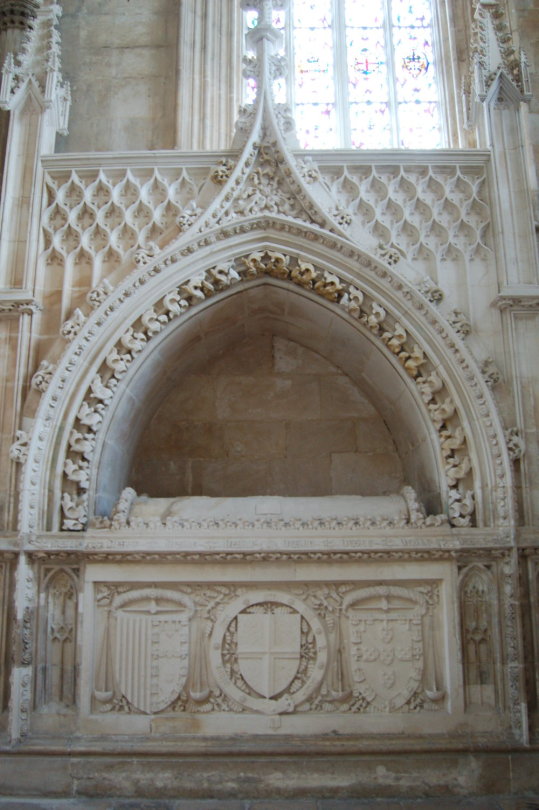
8 notes
·
View notes